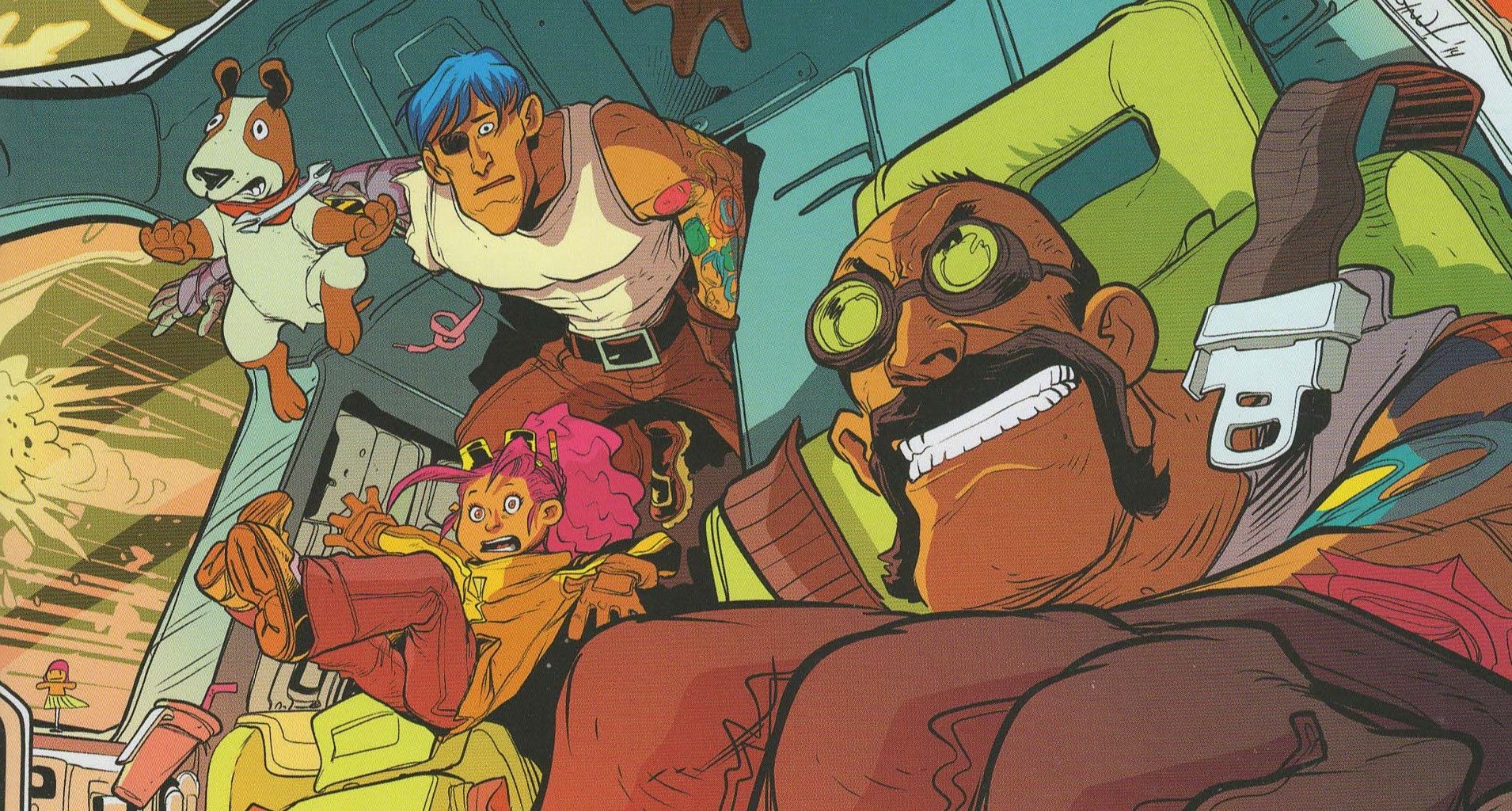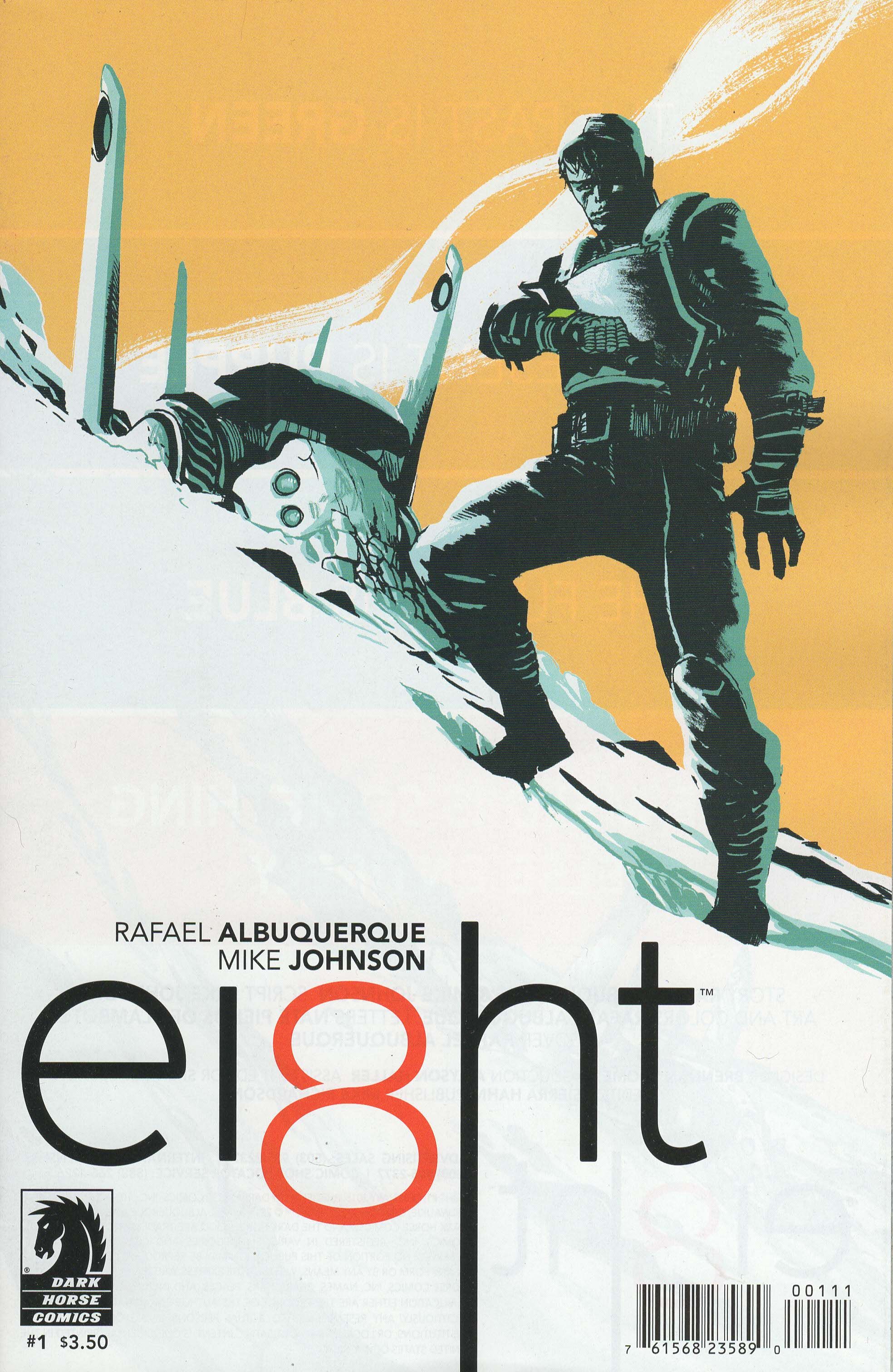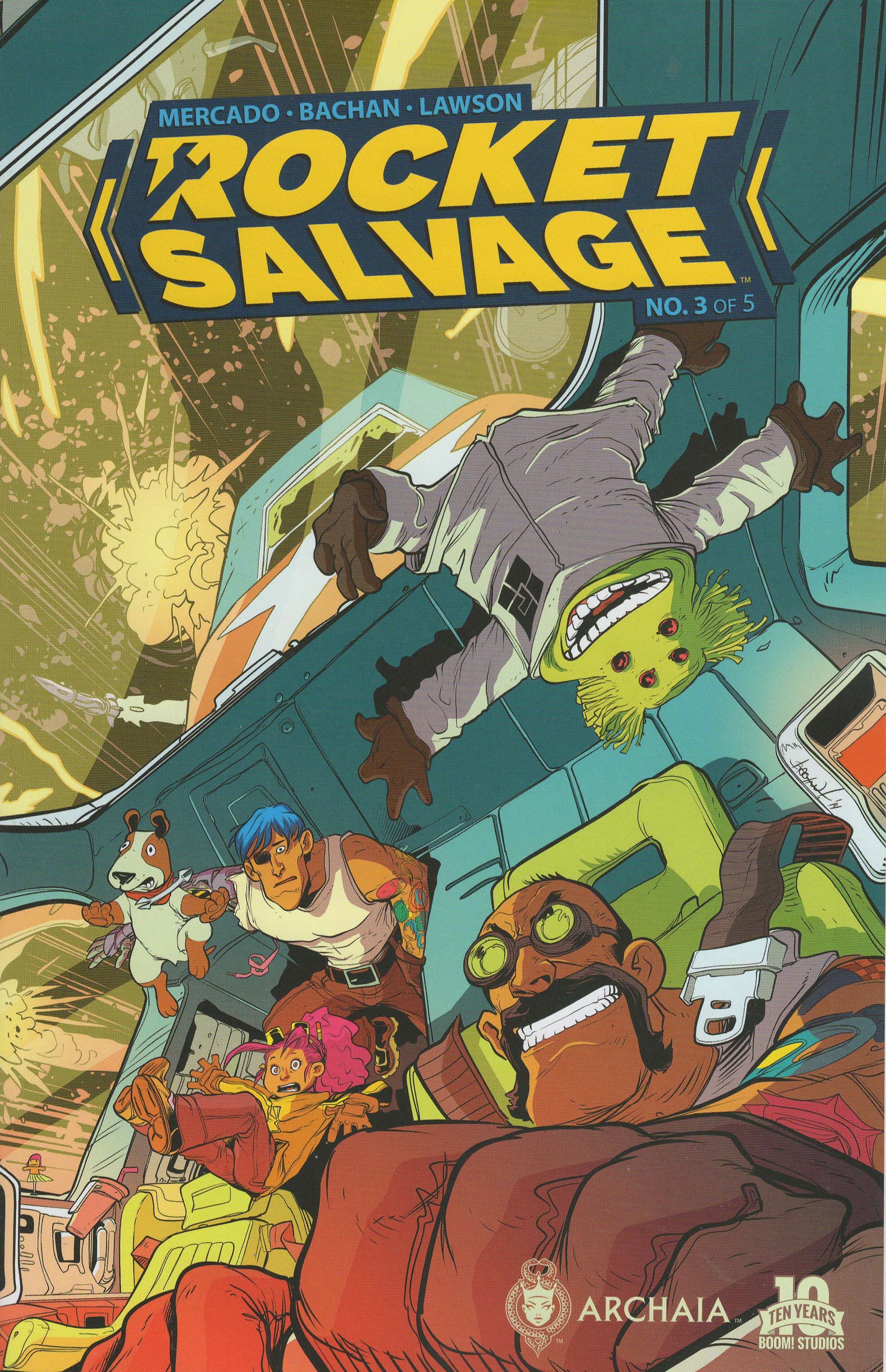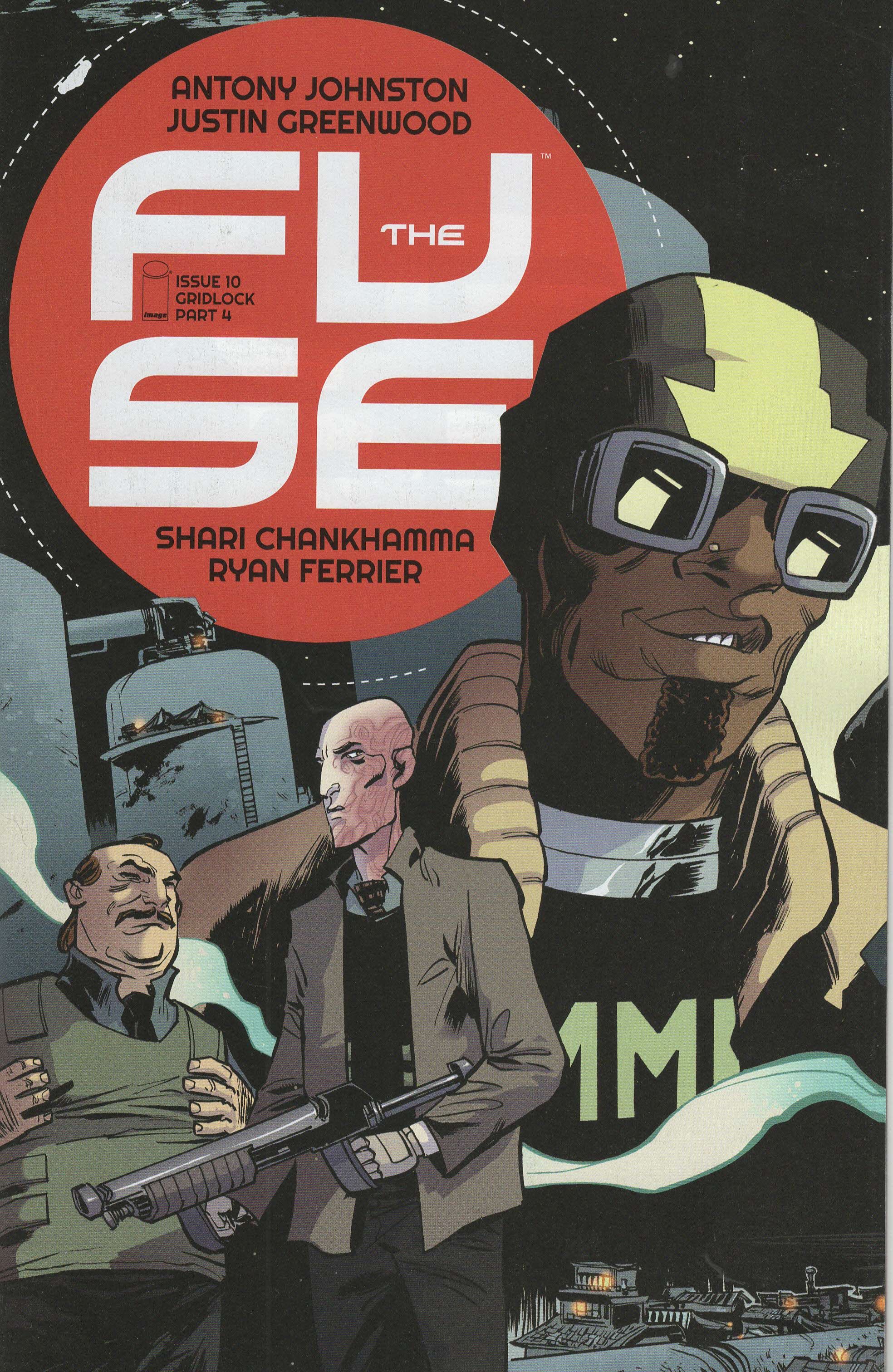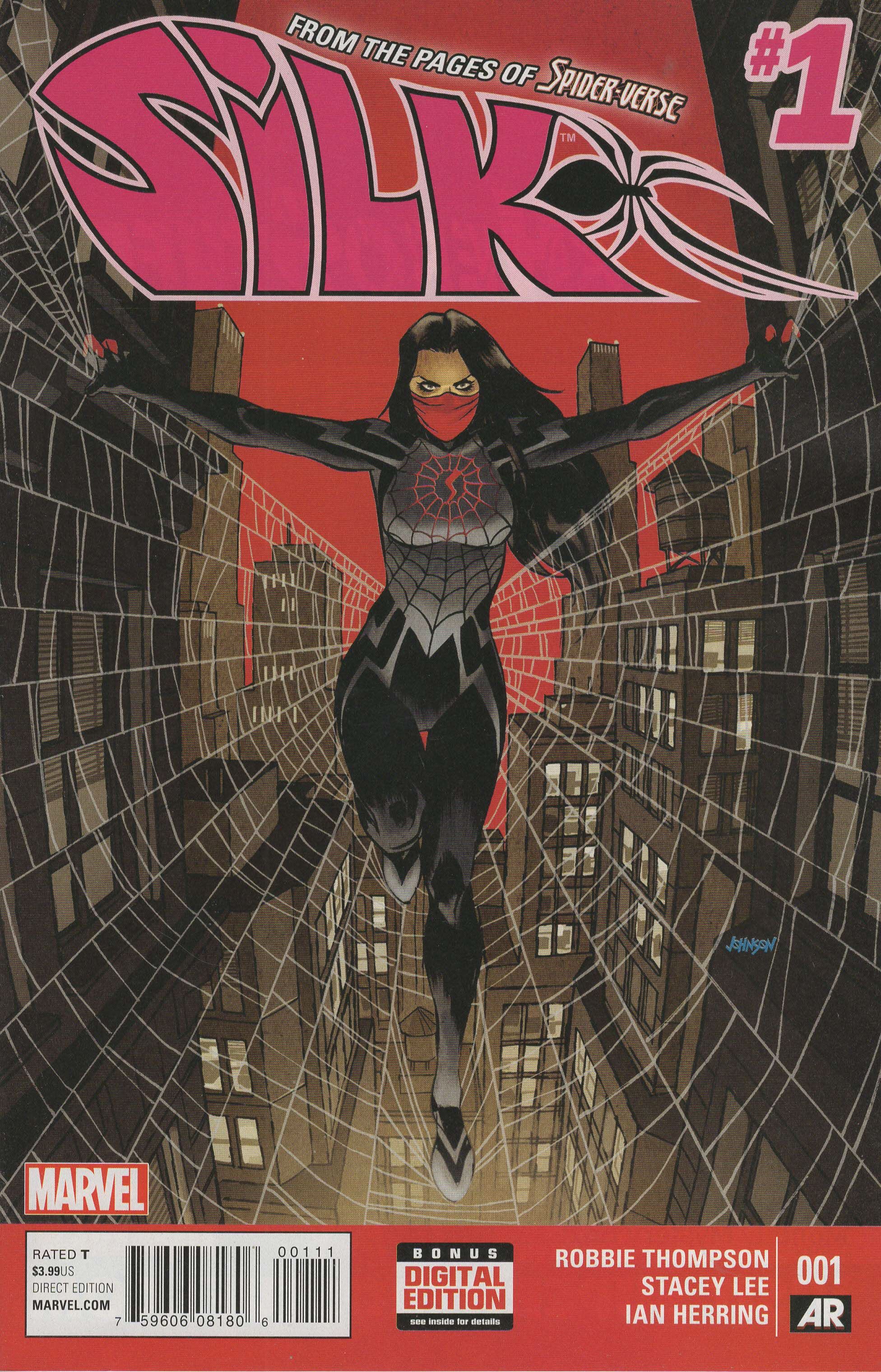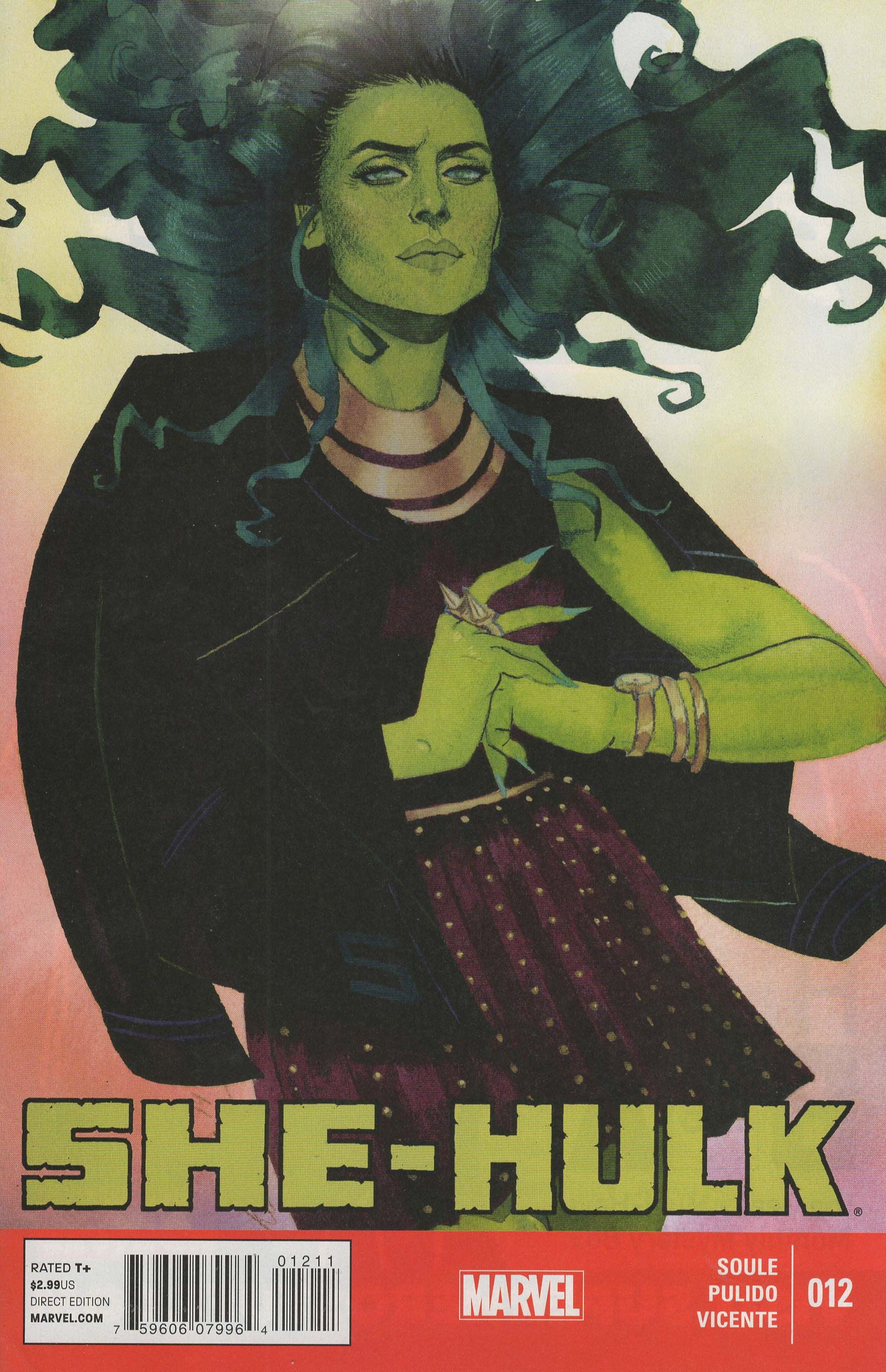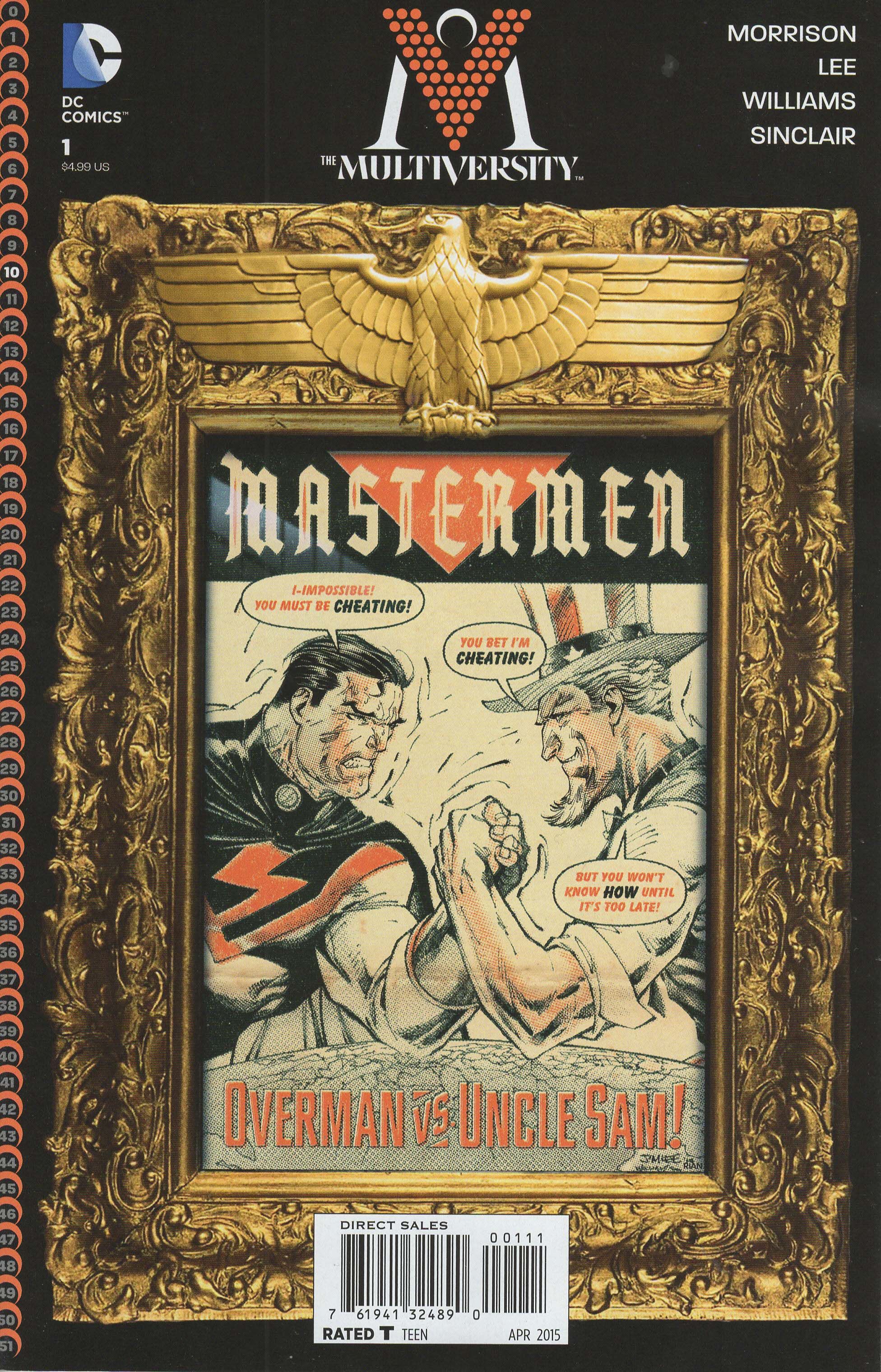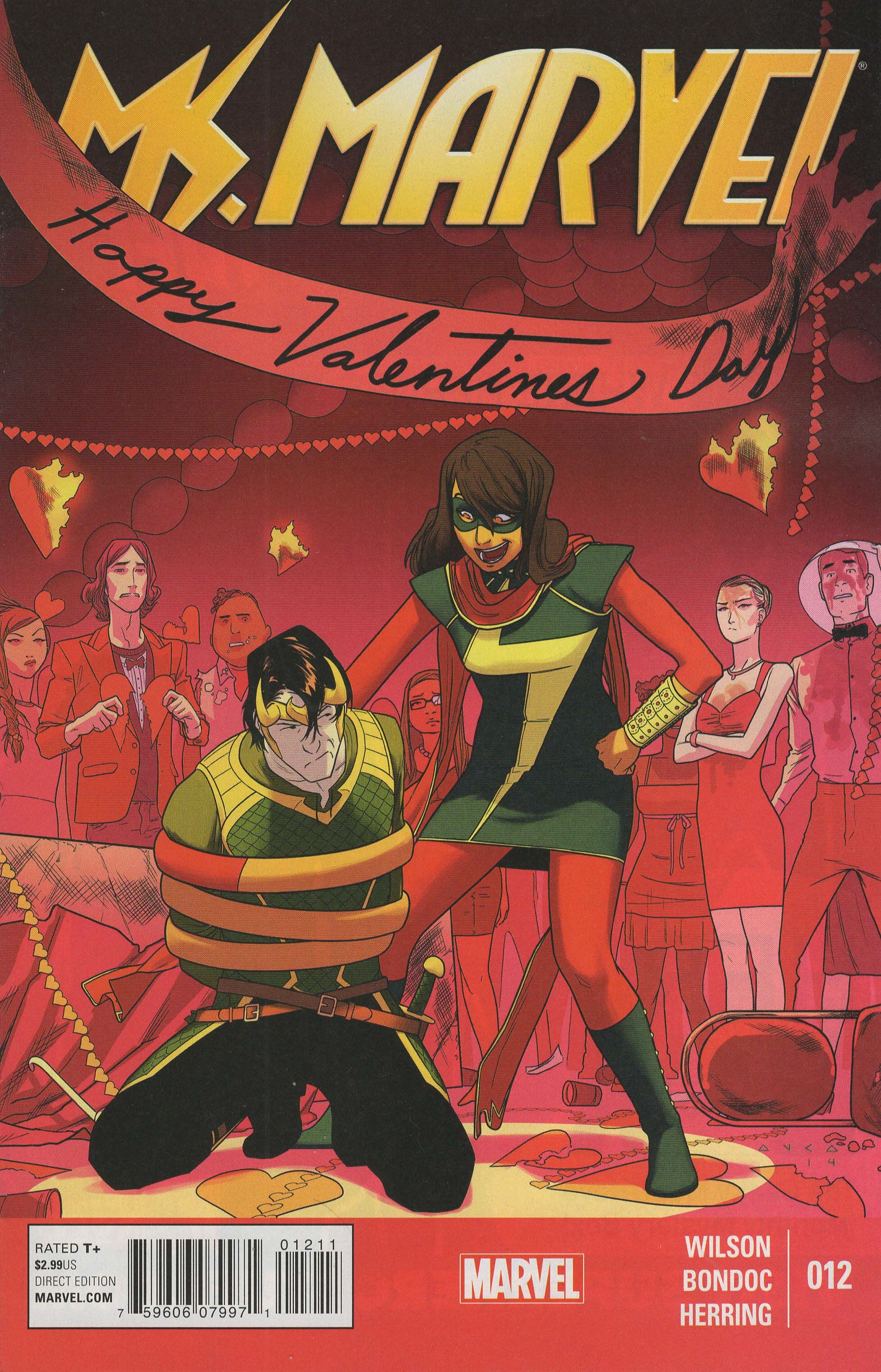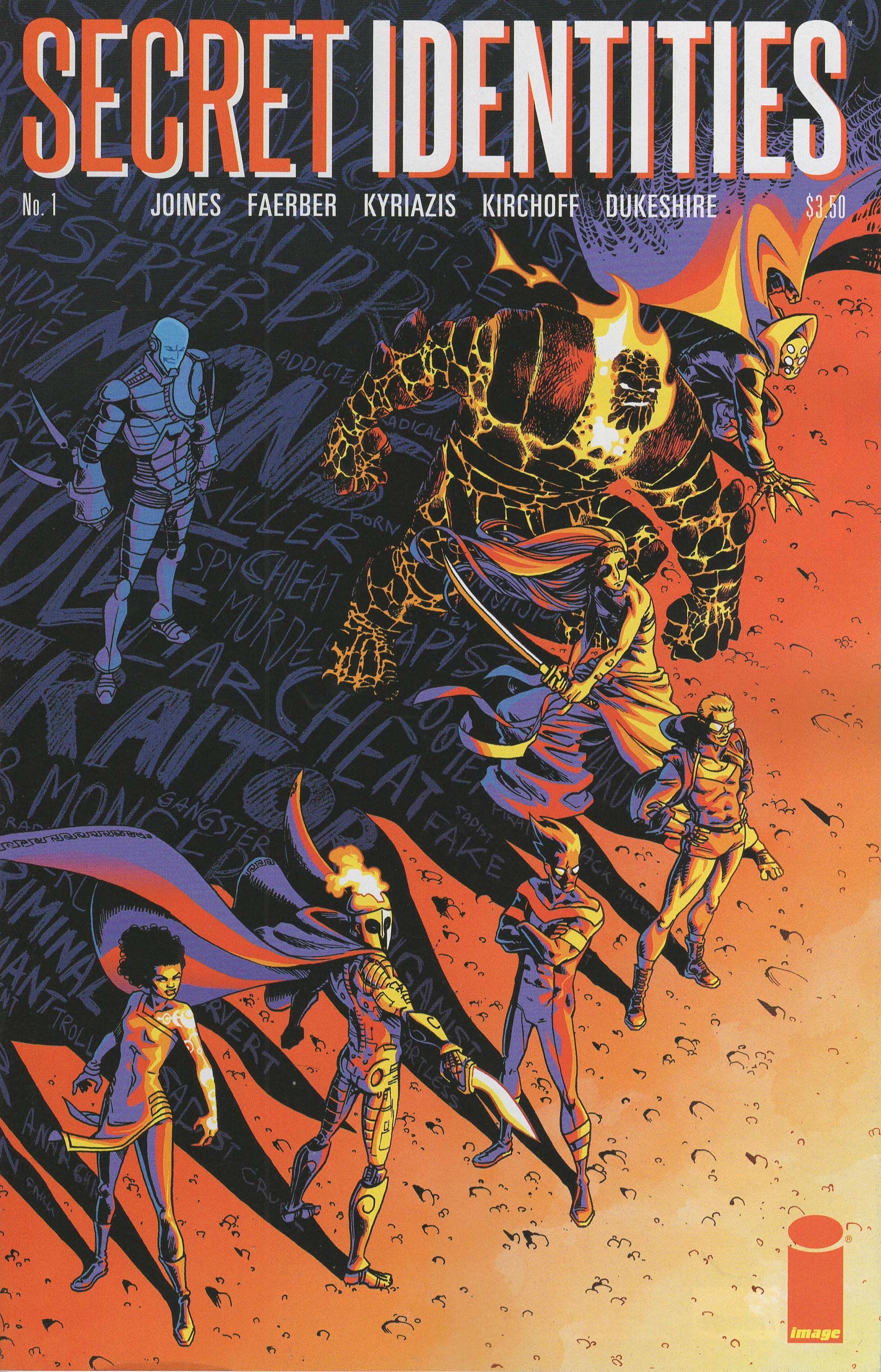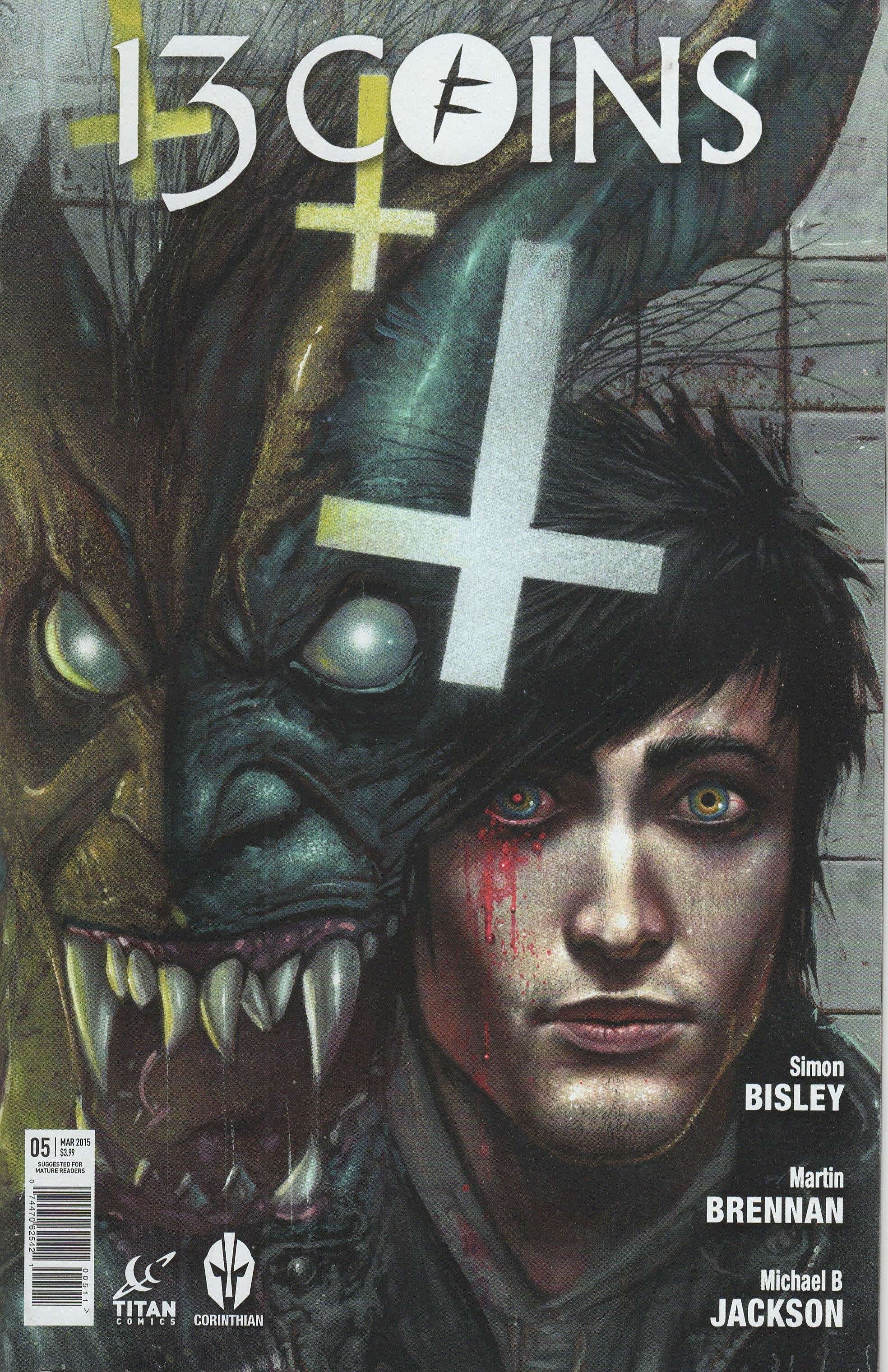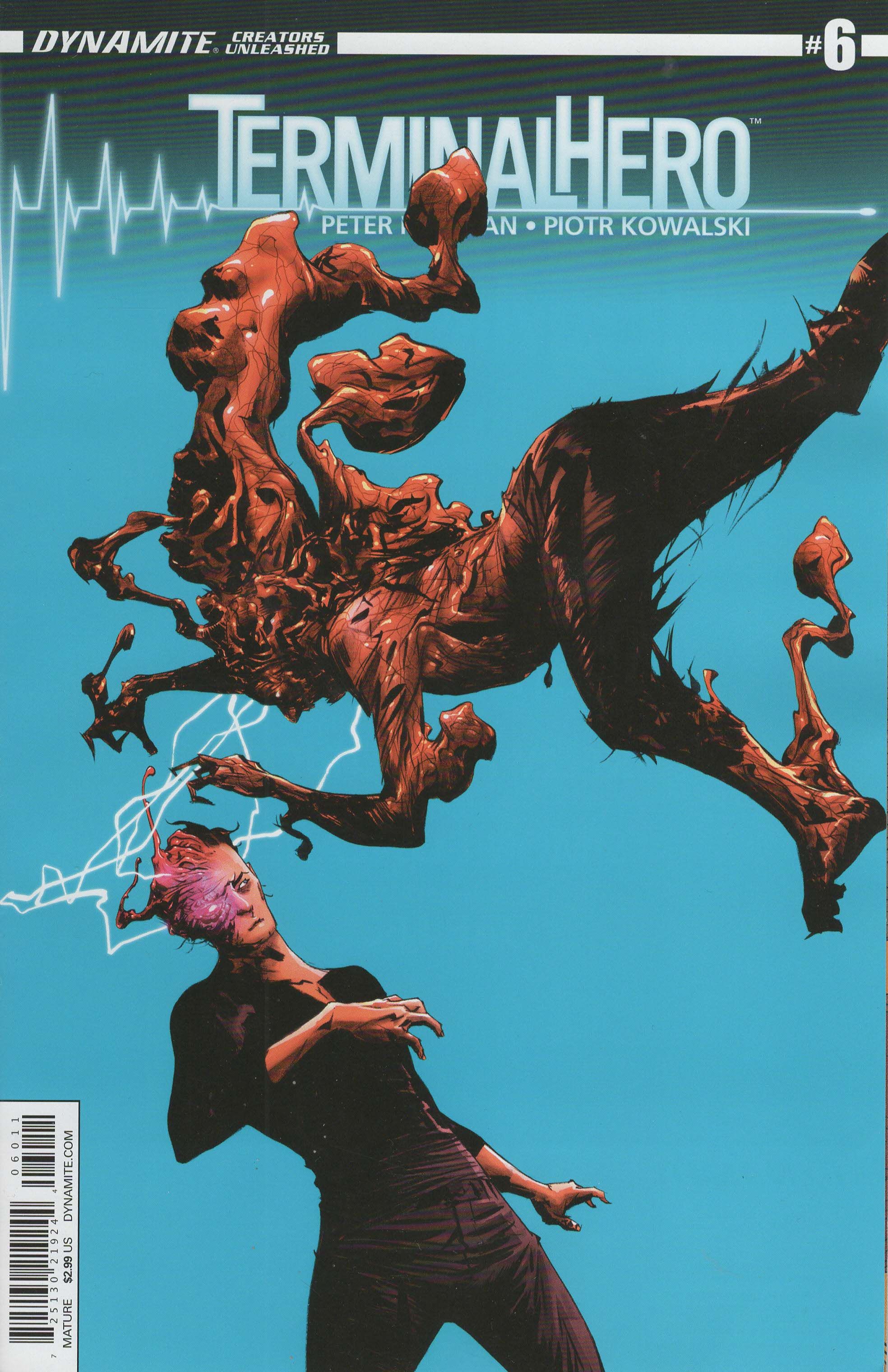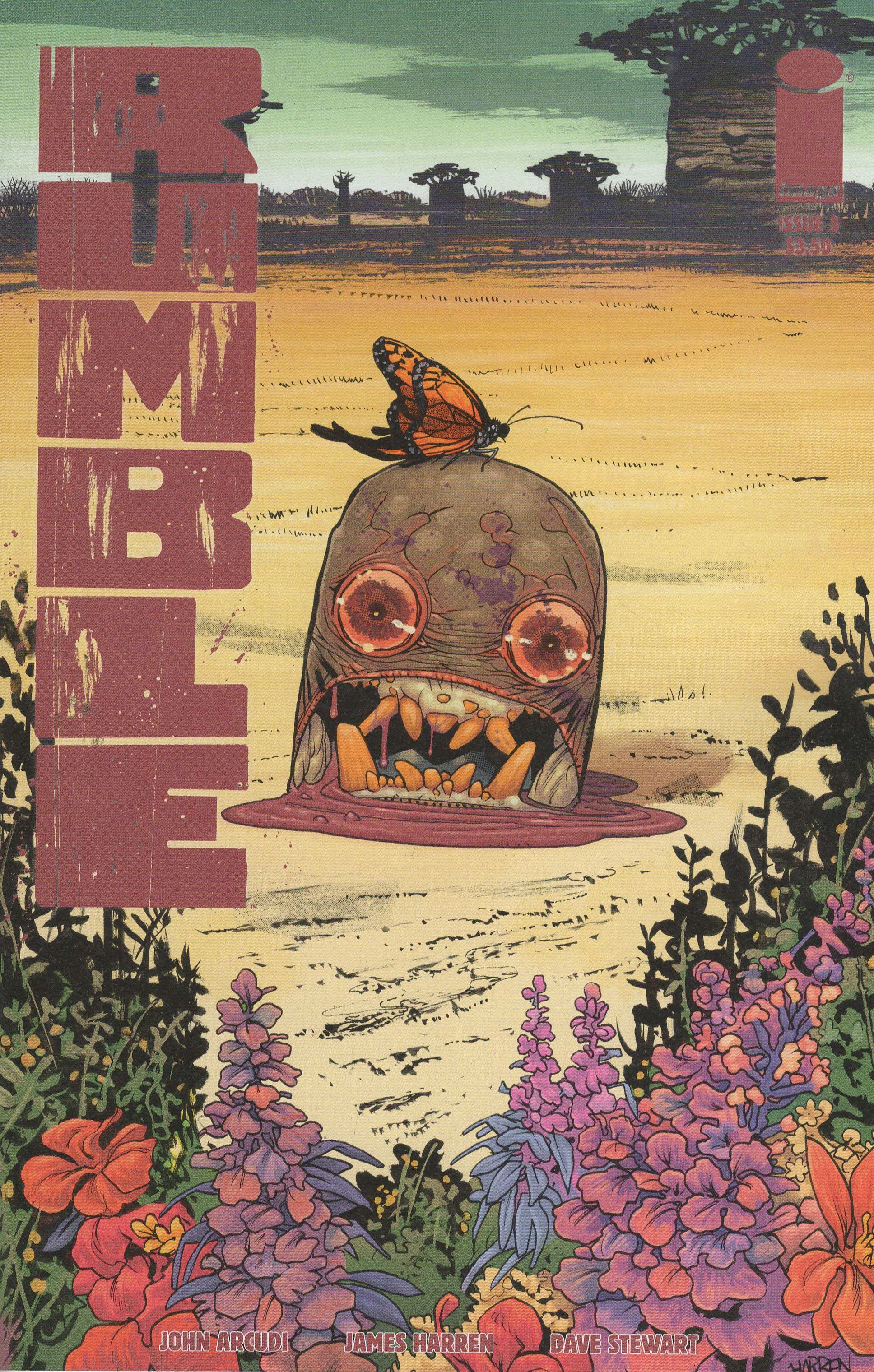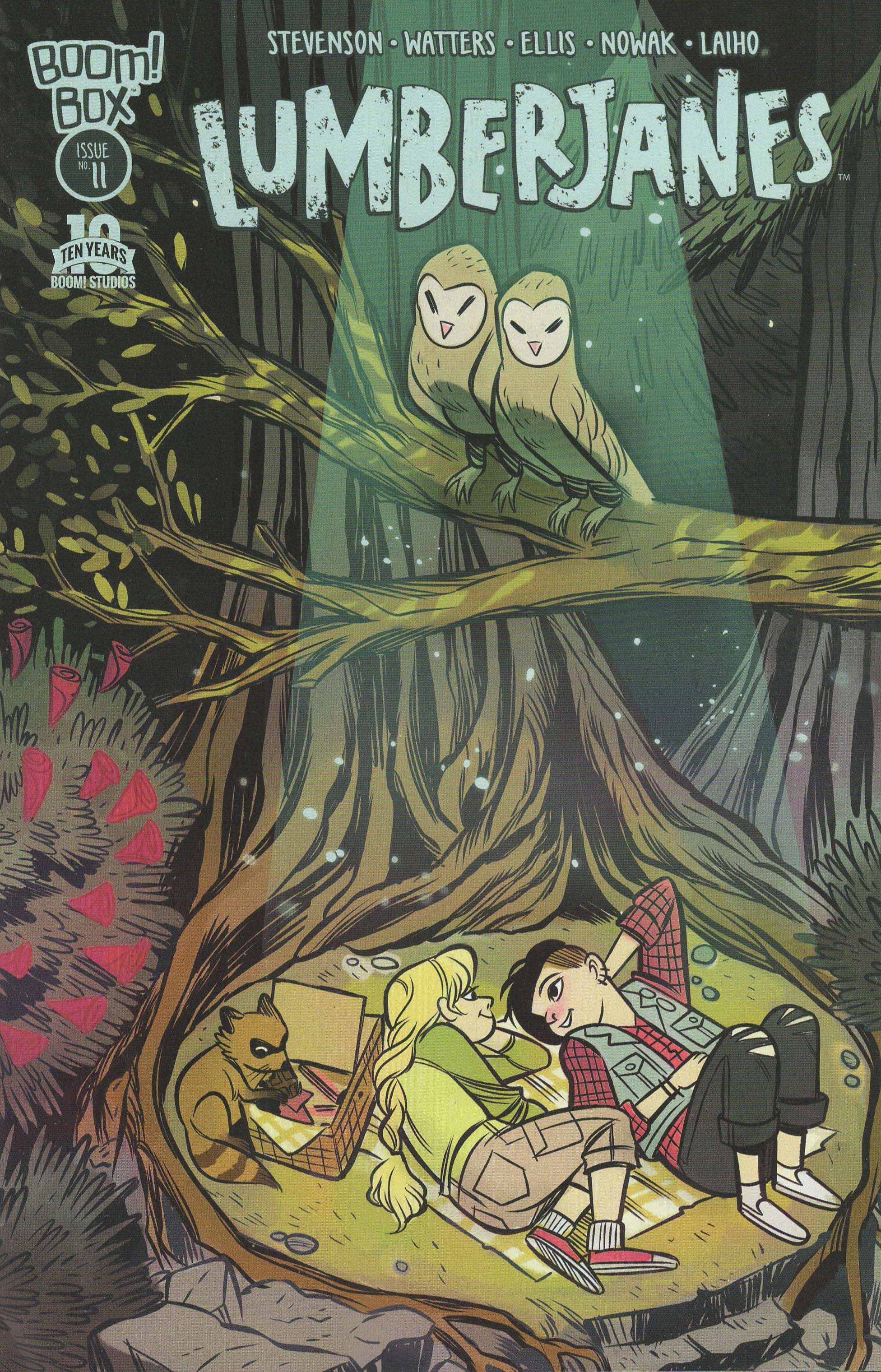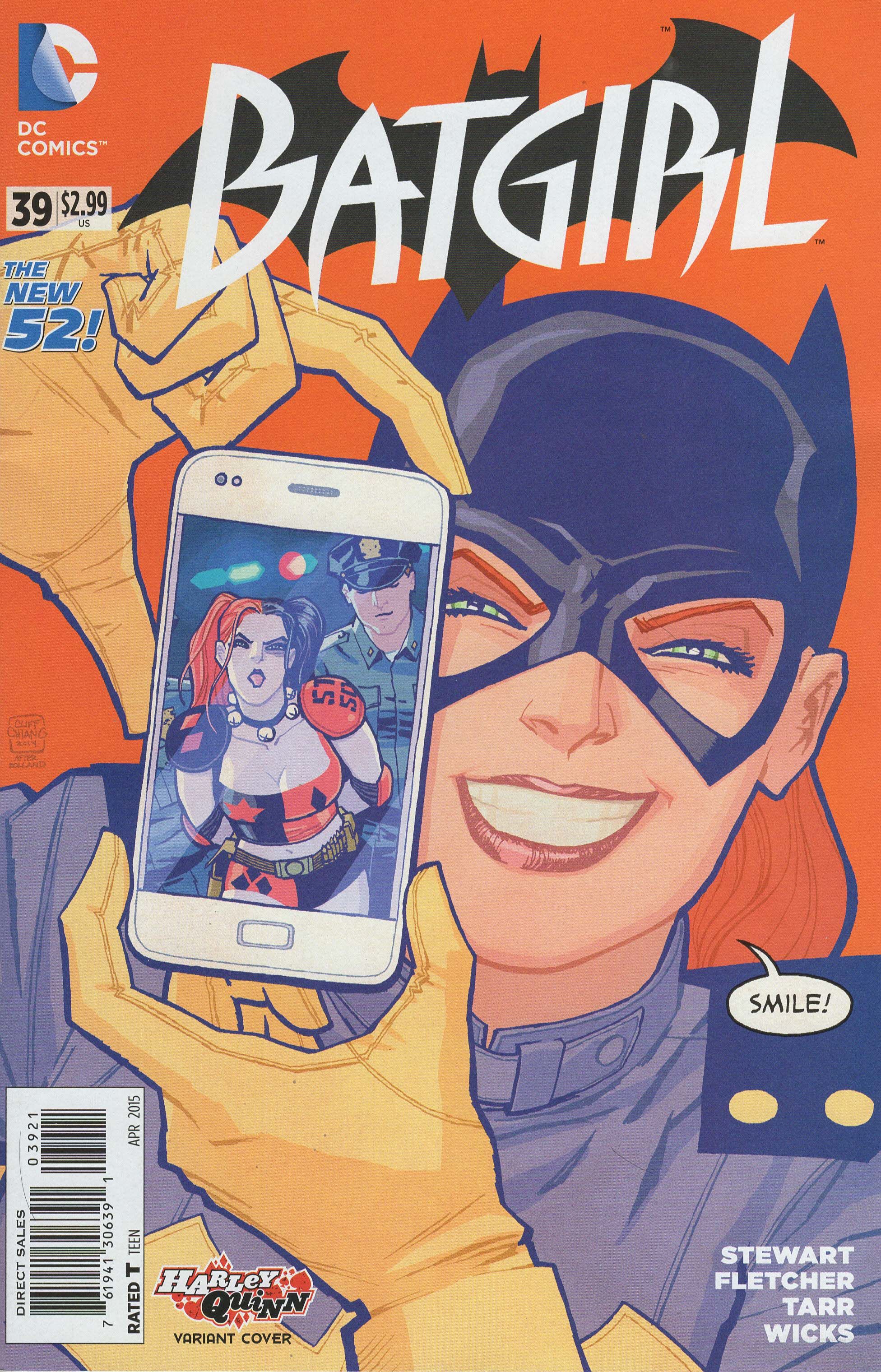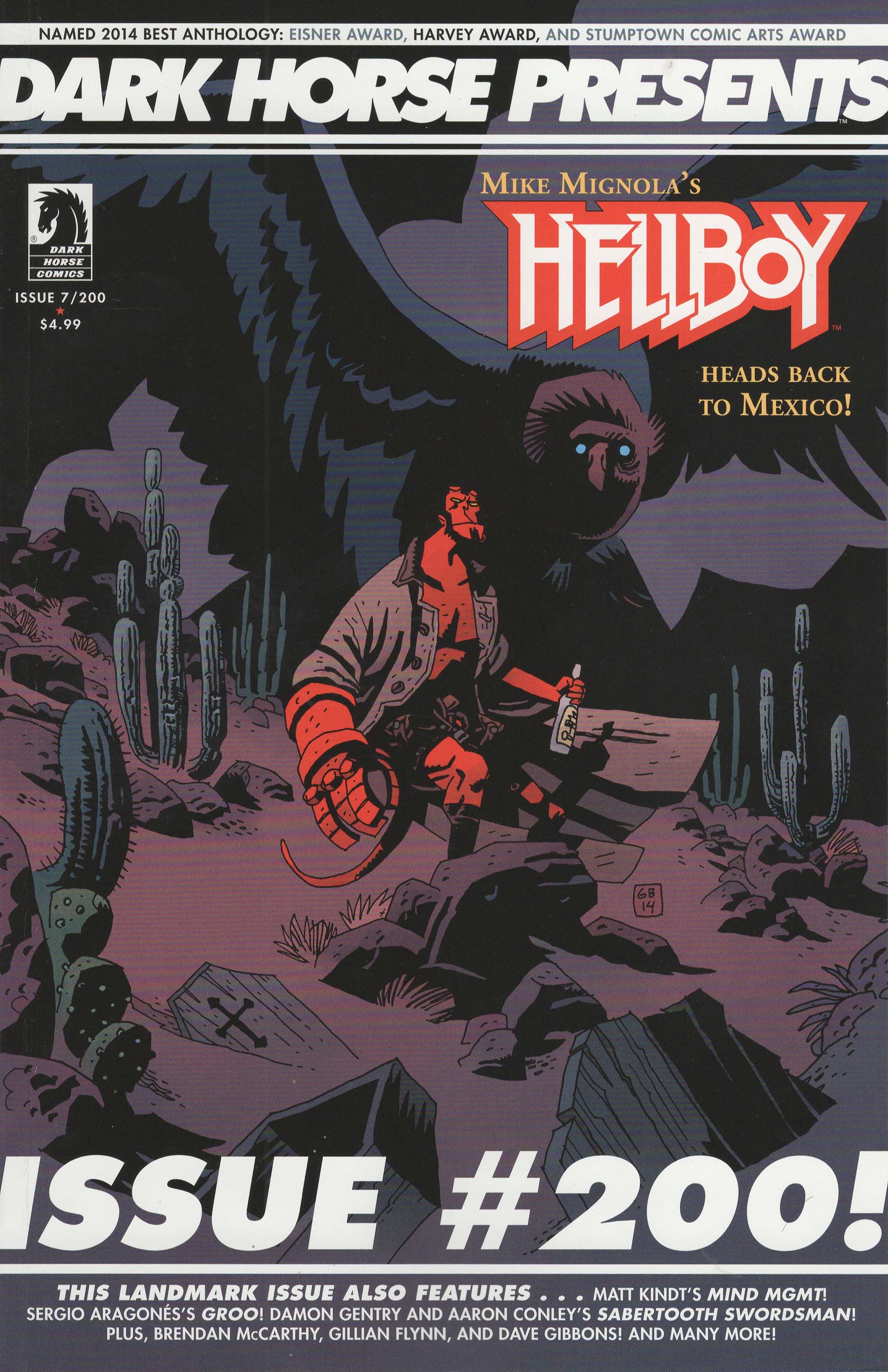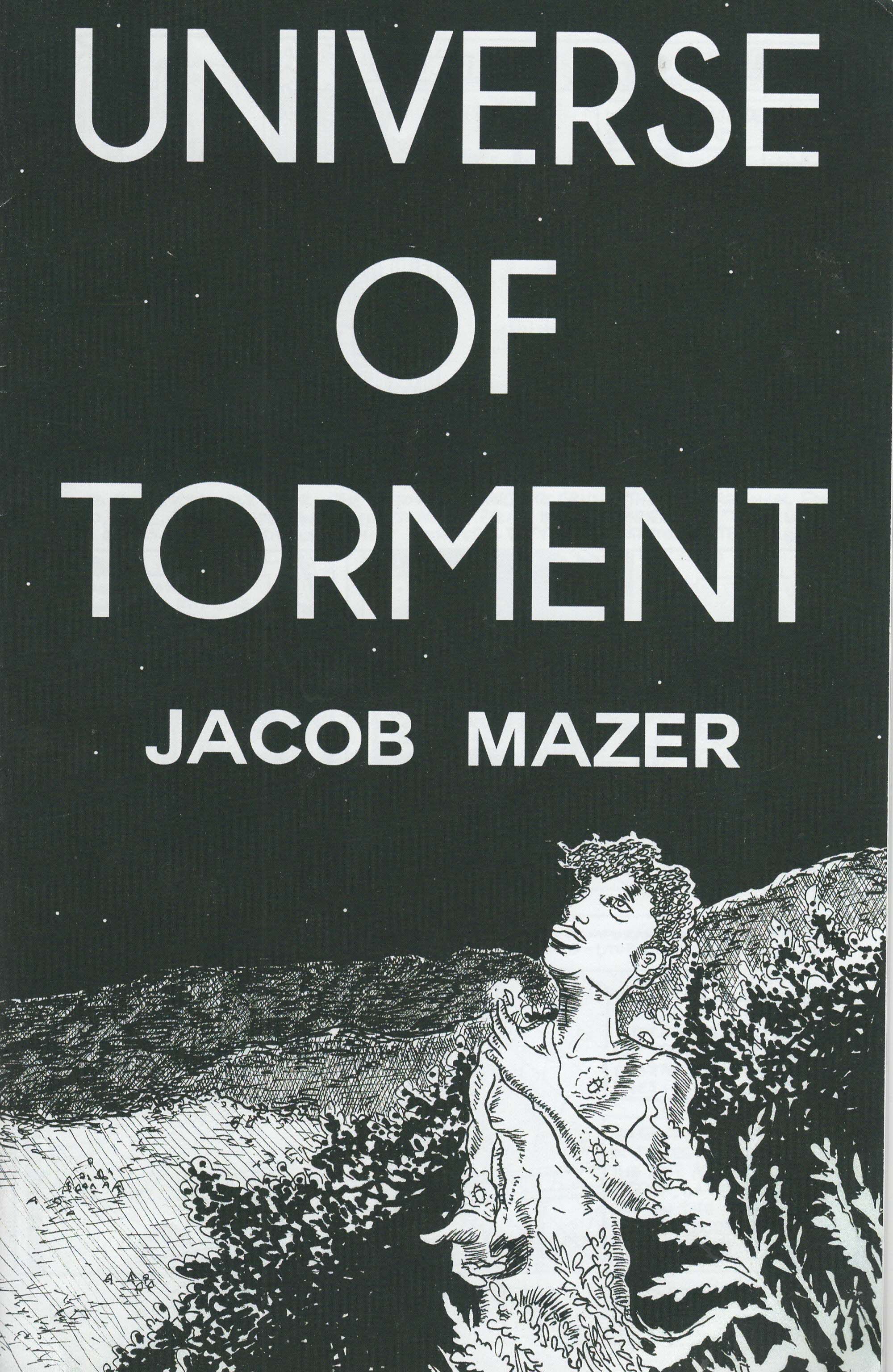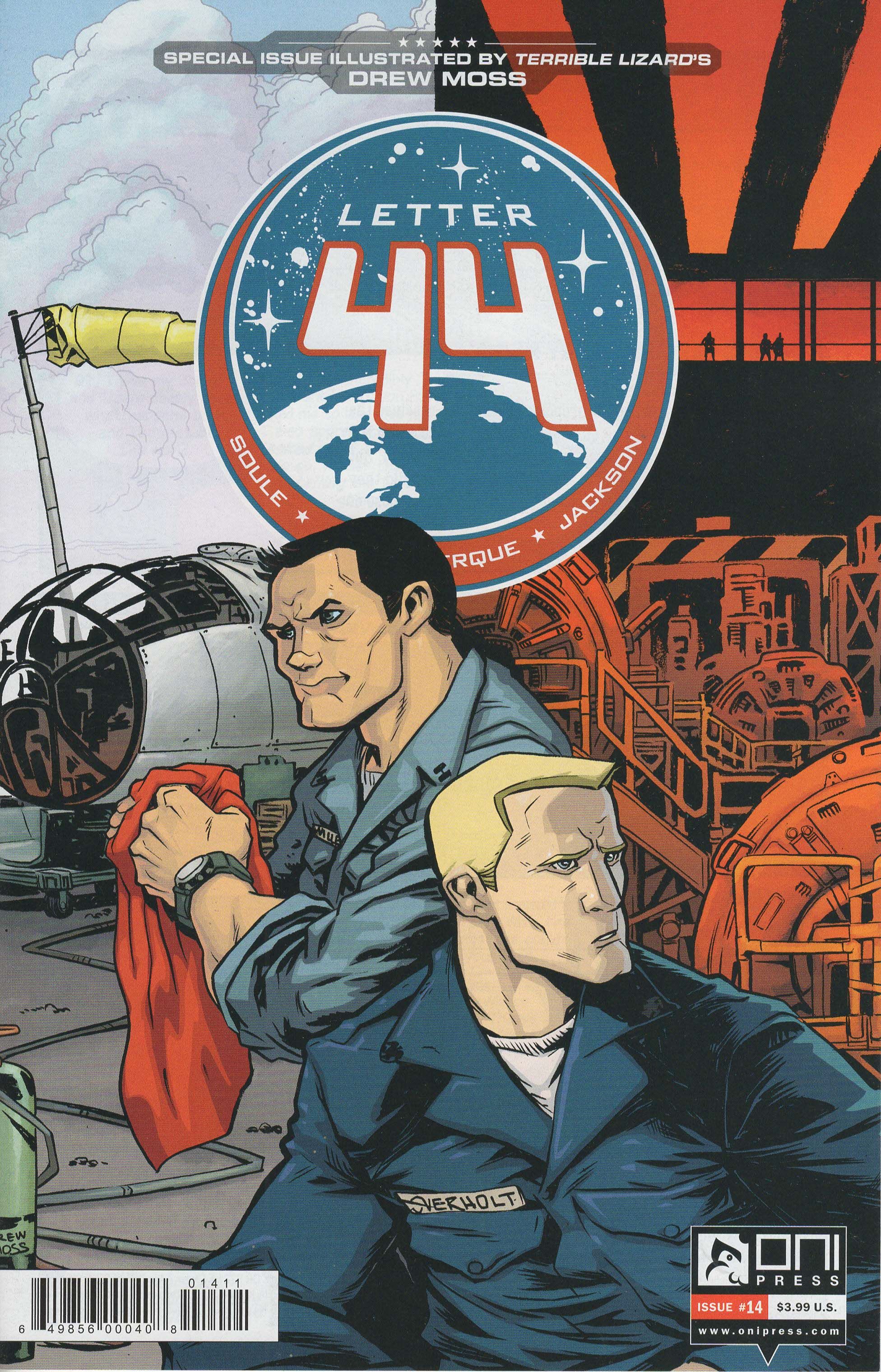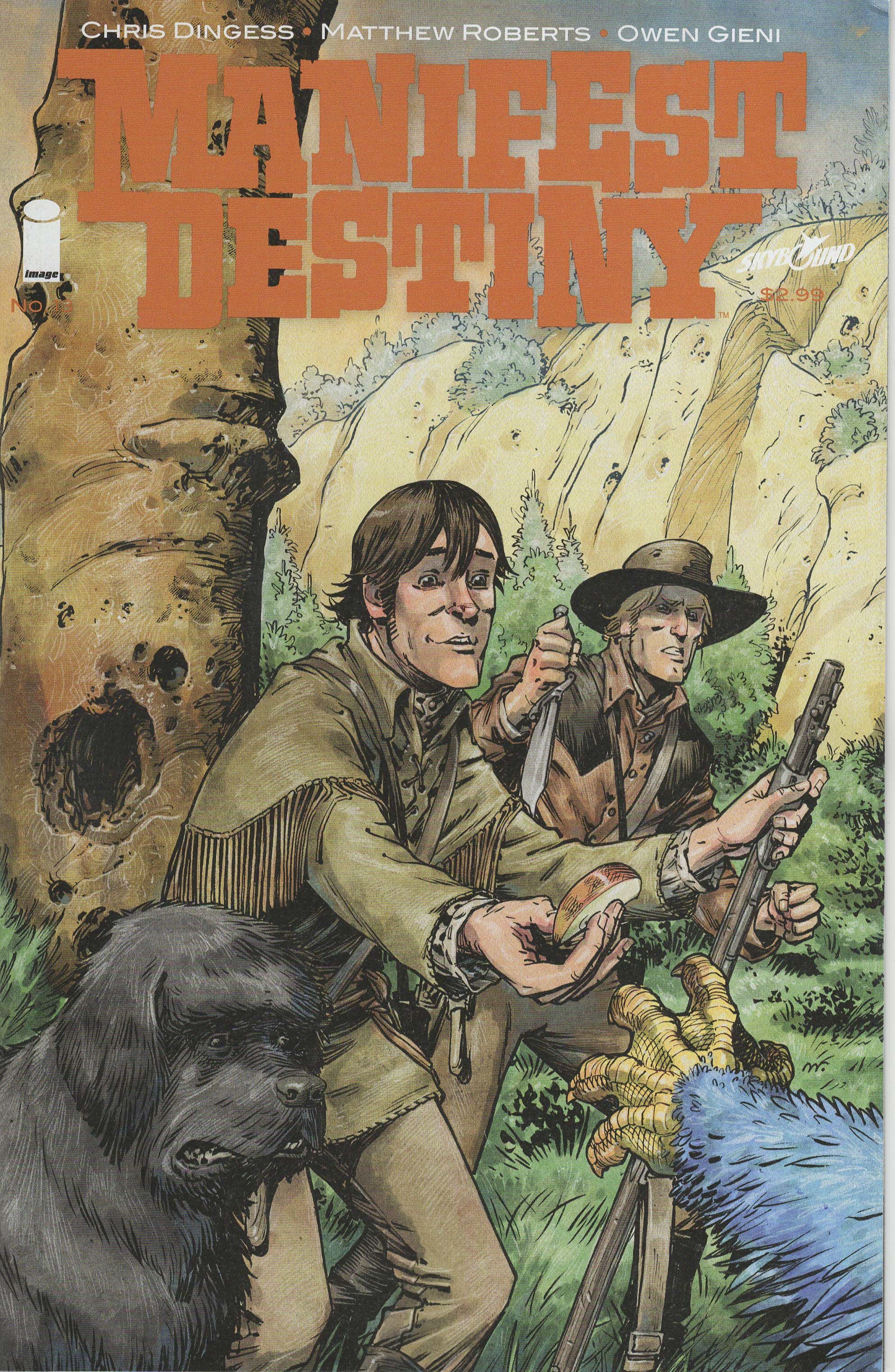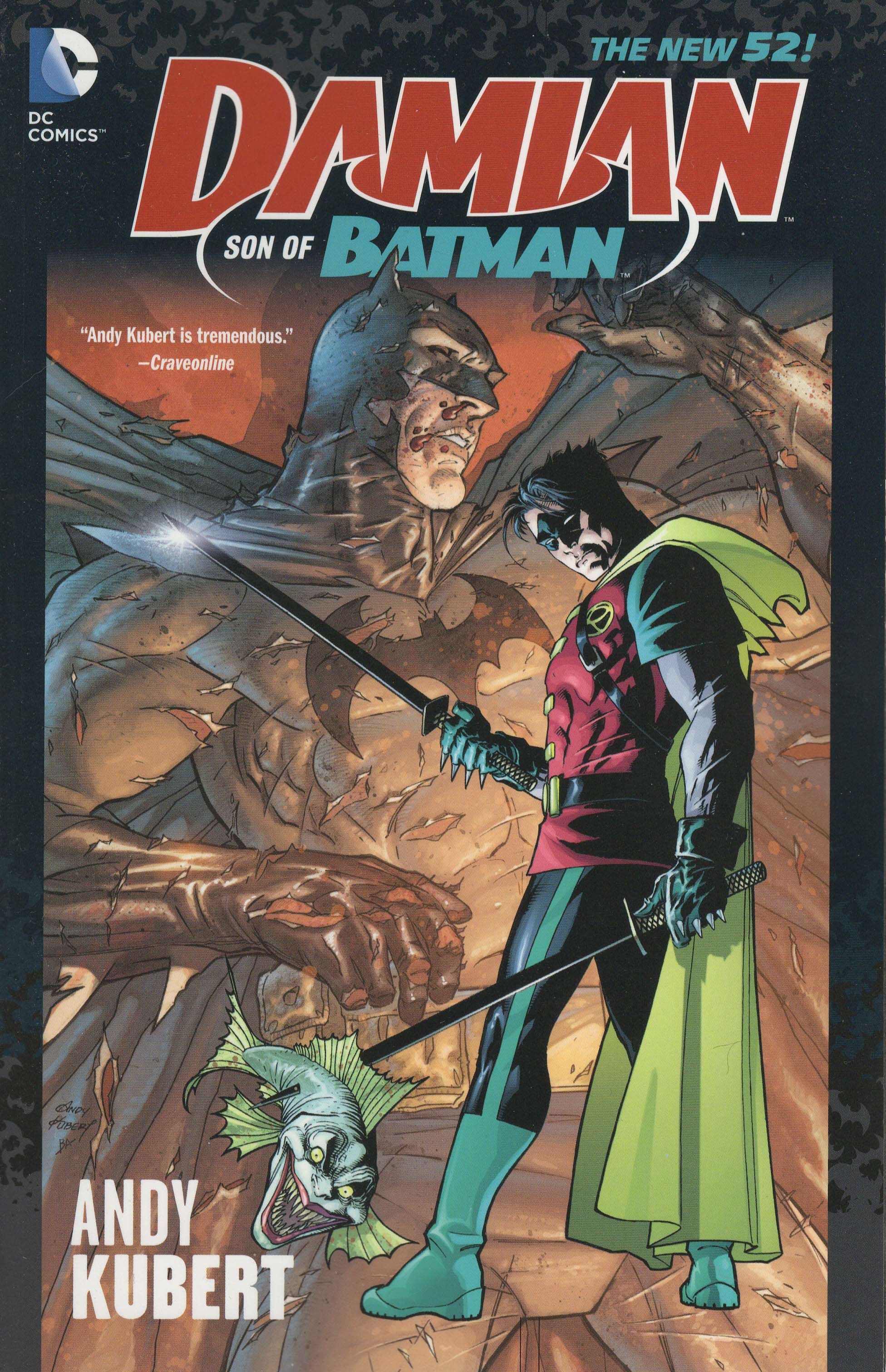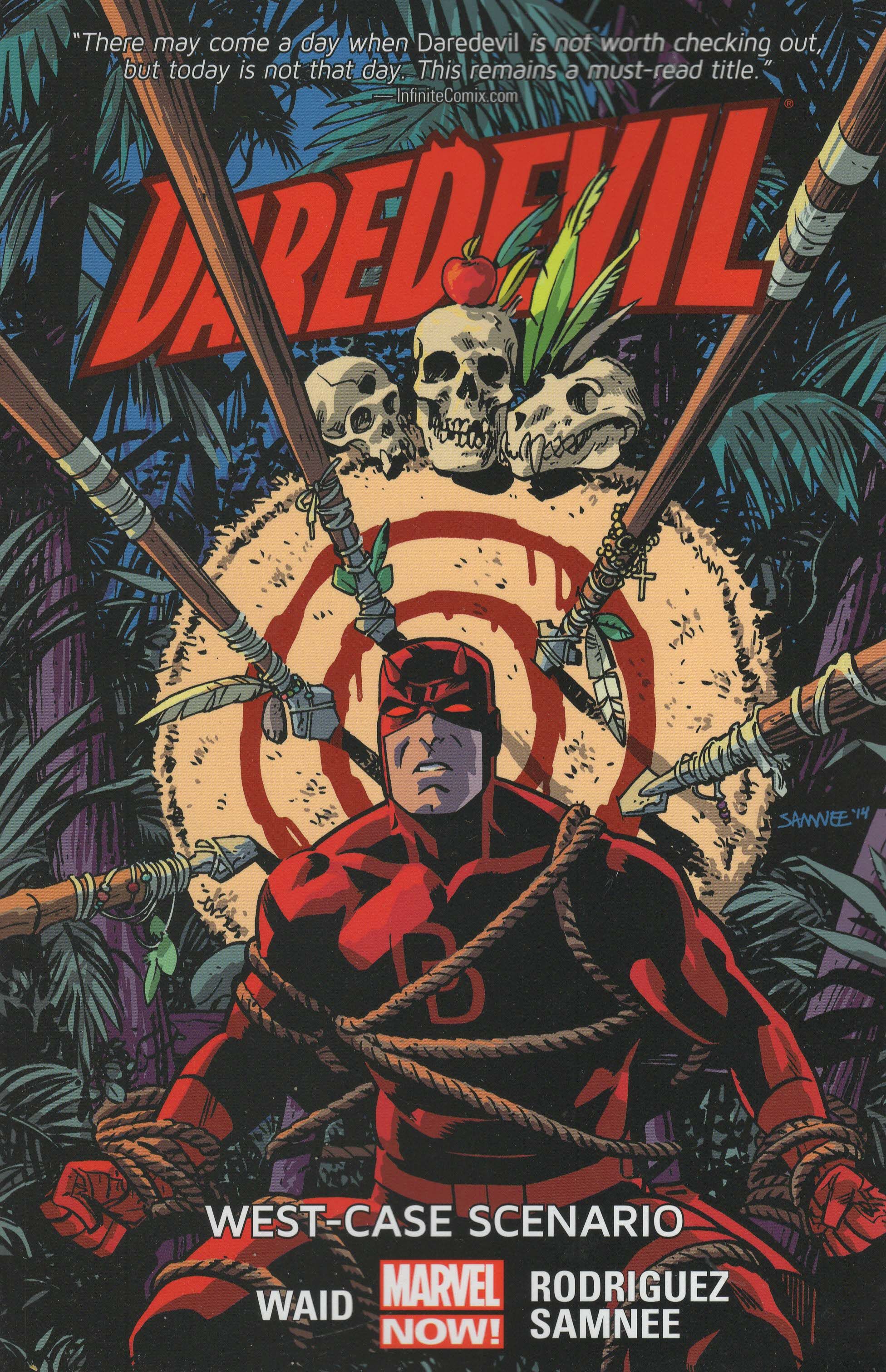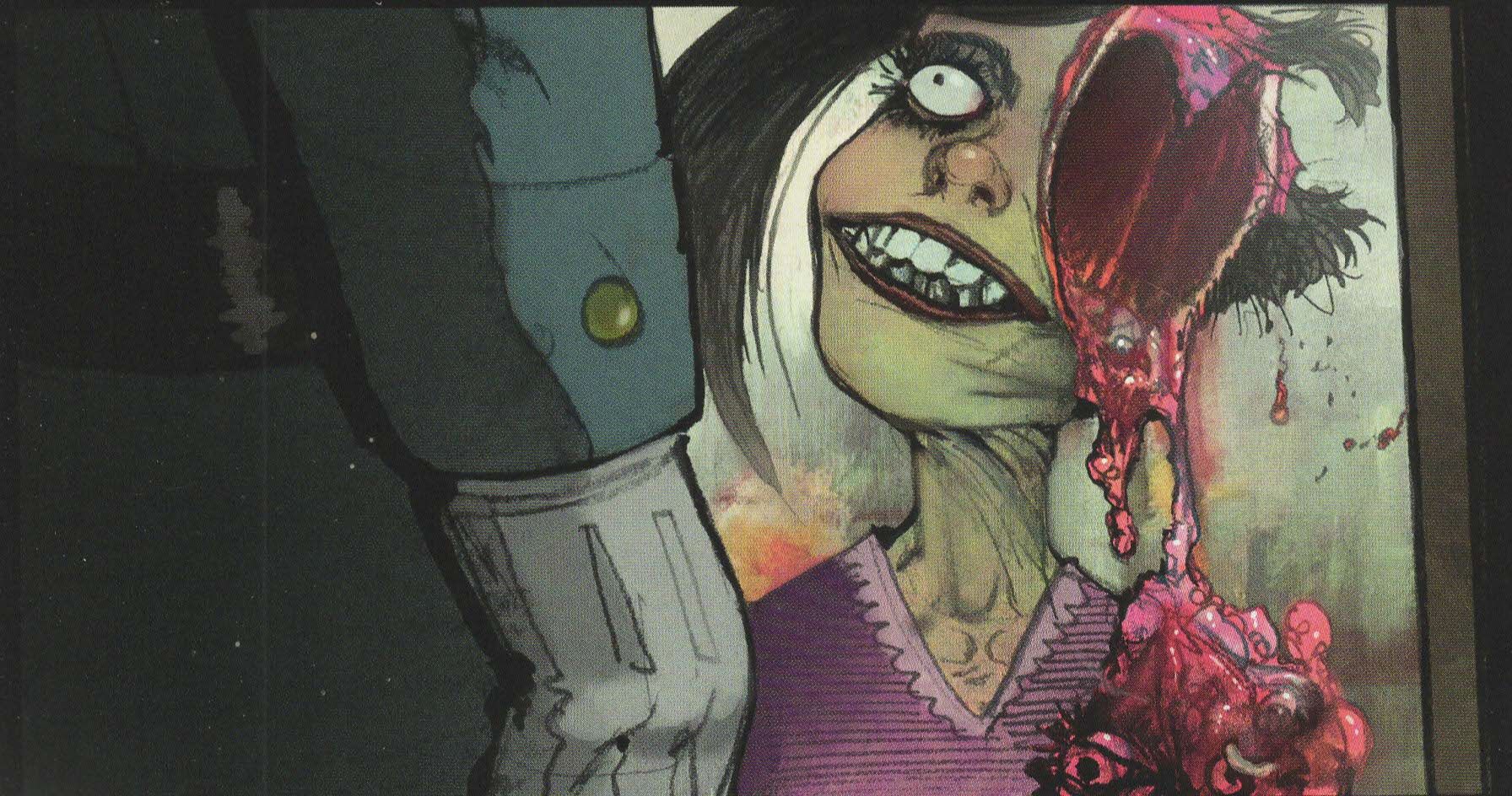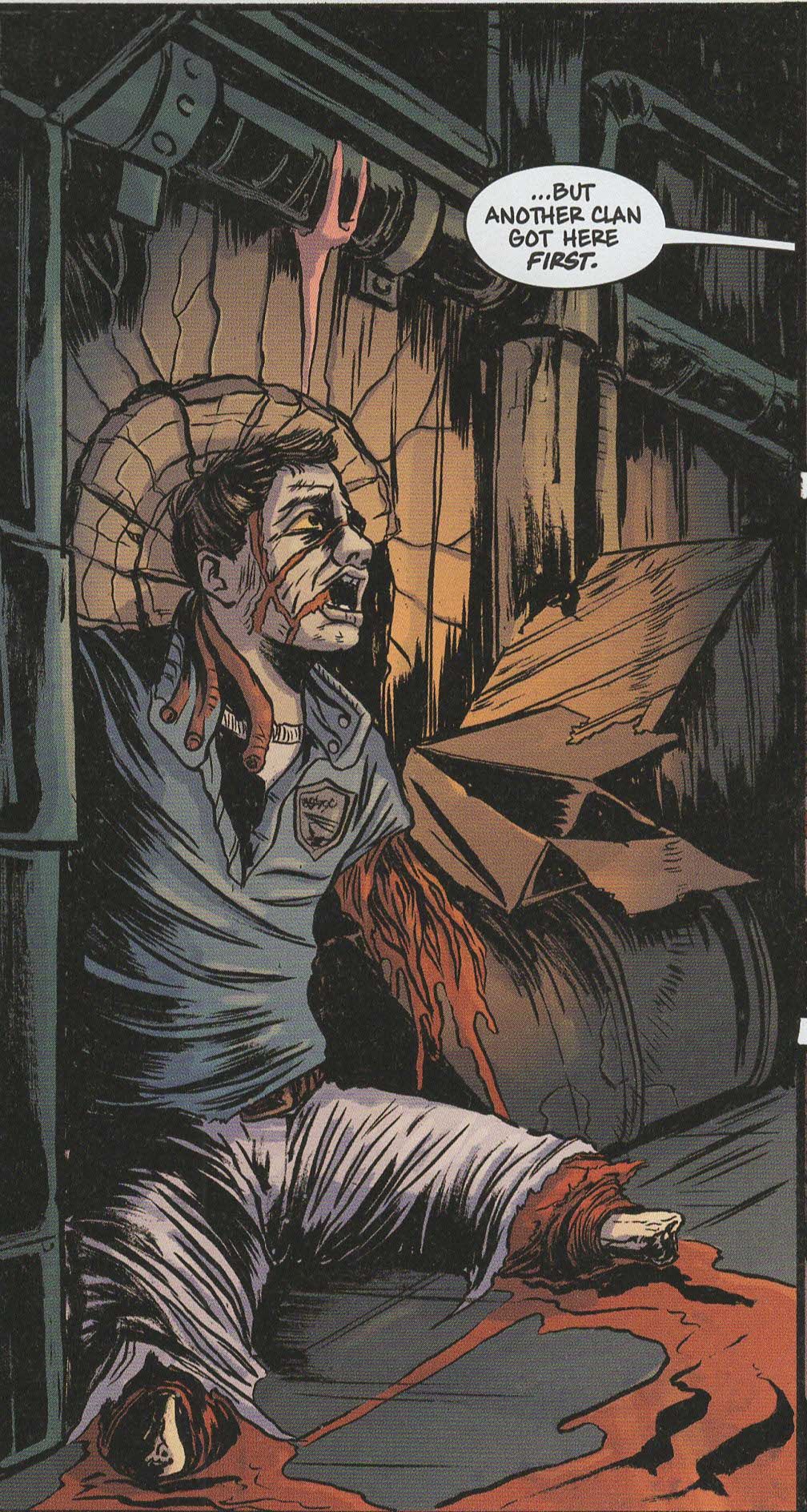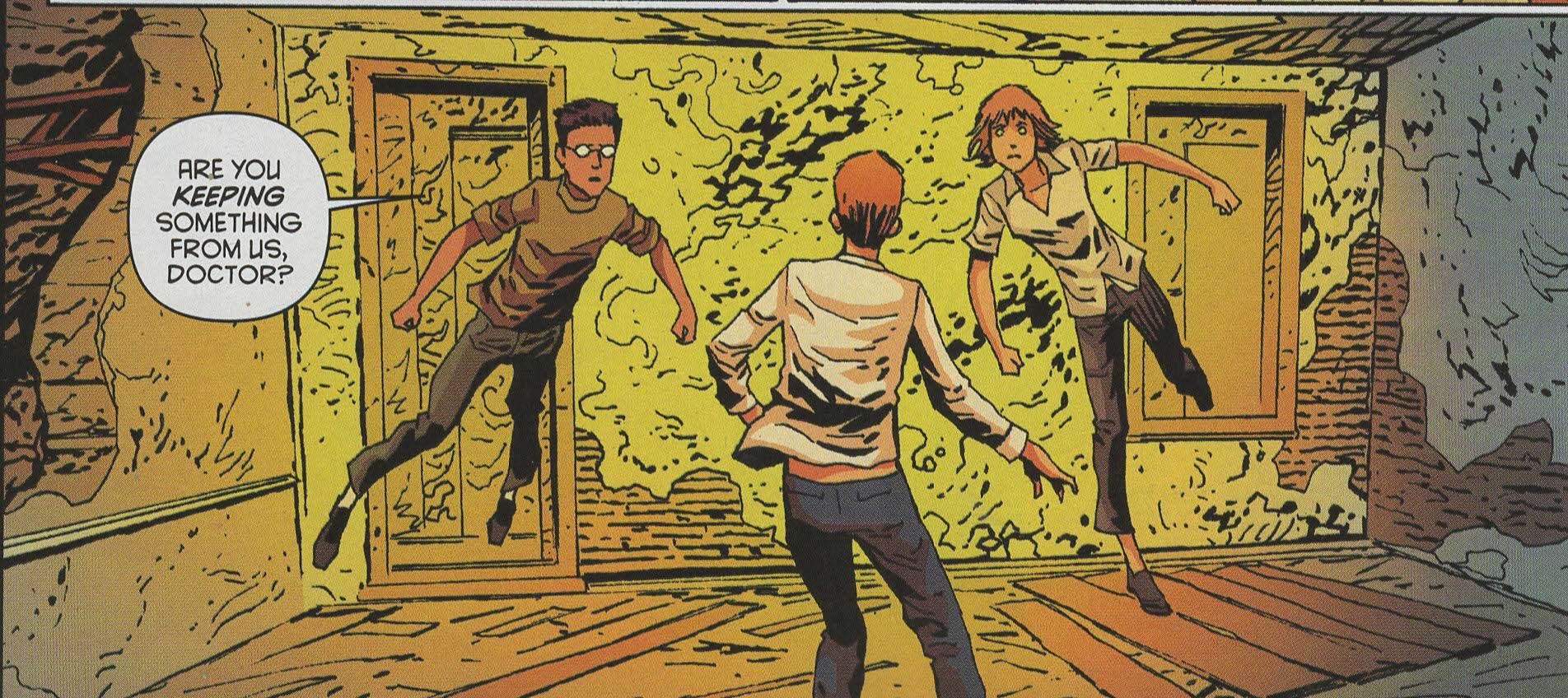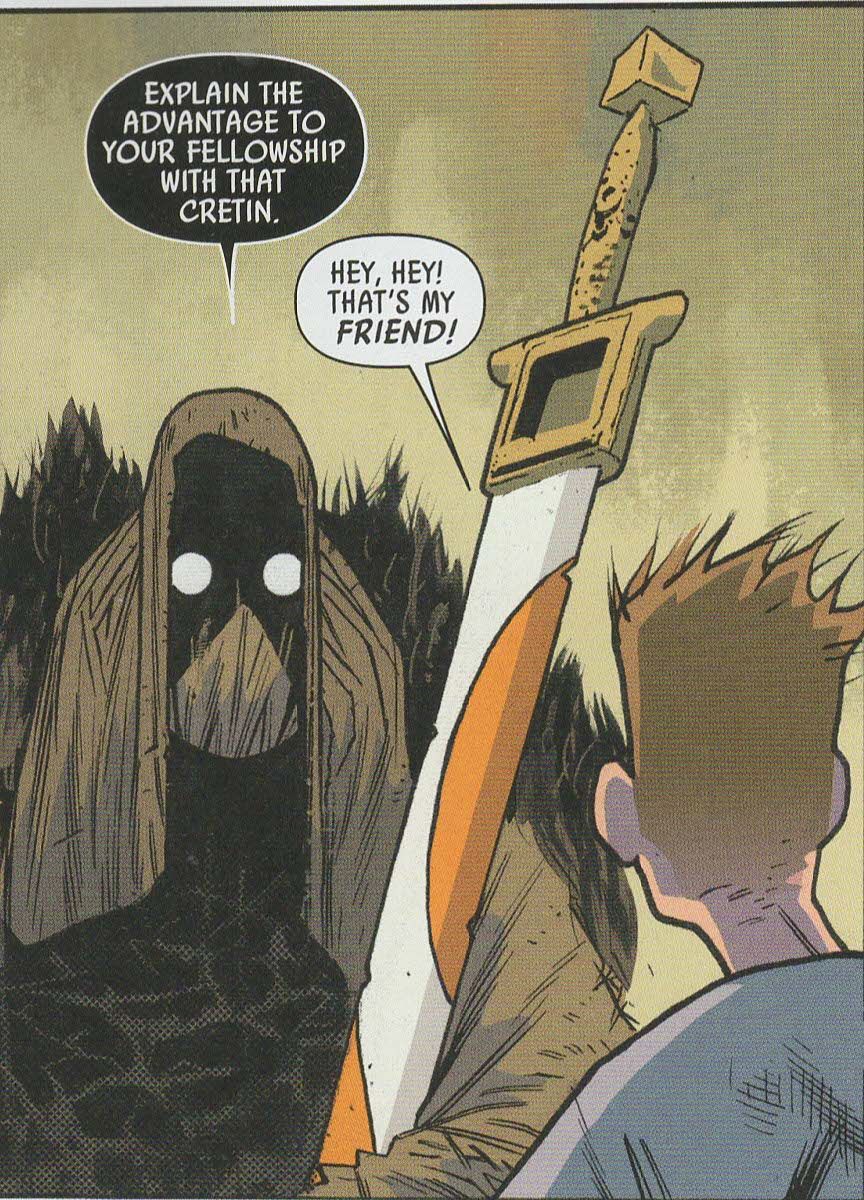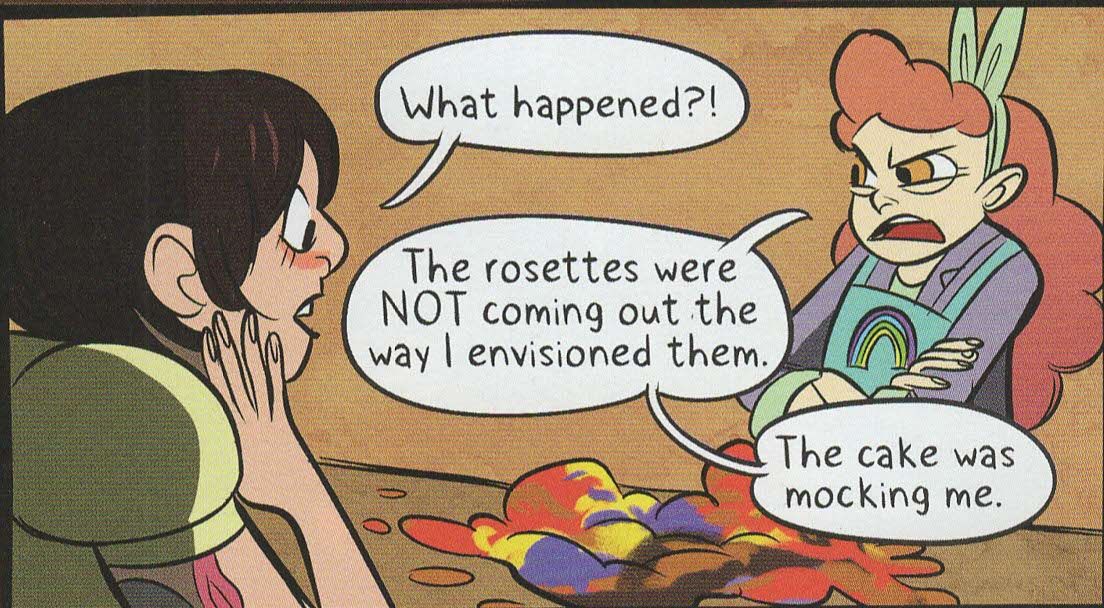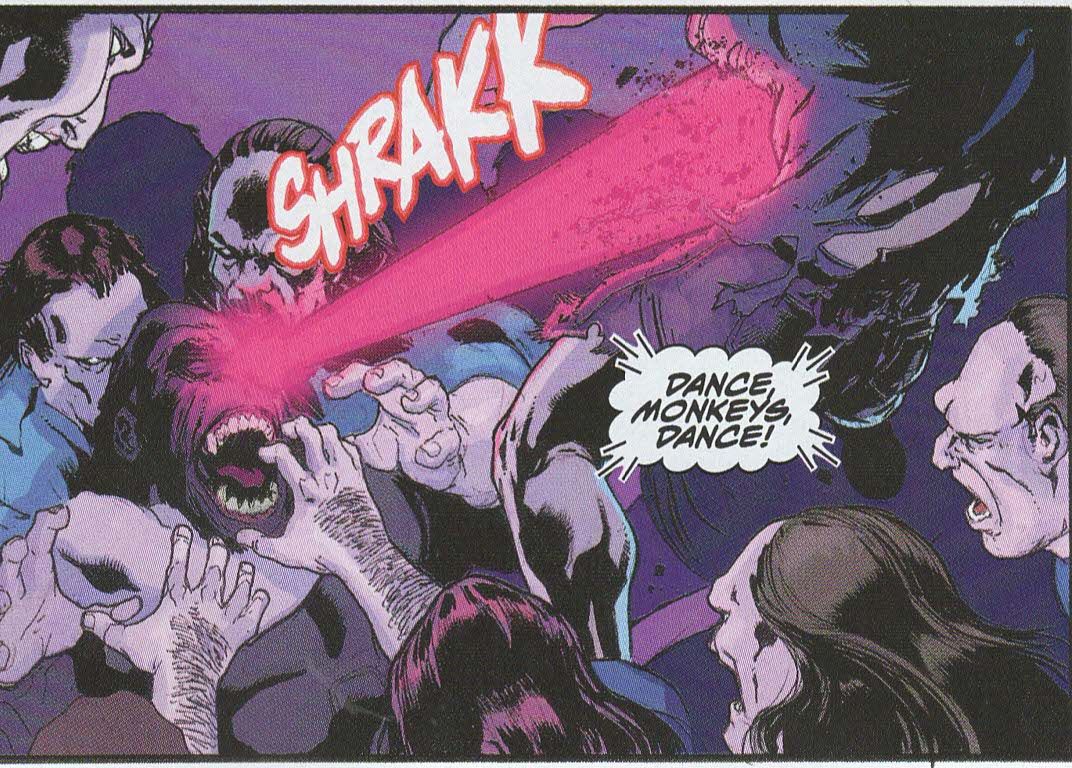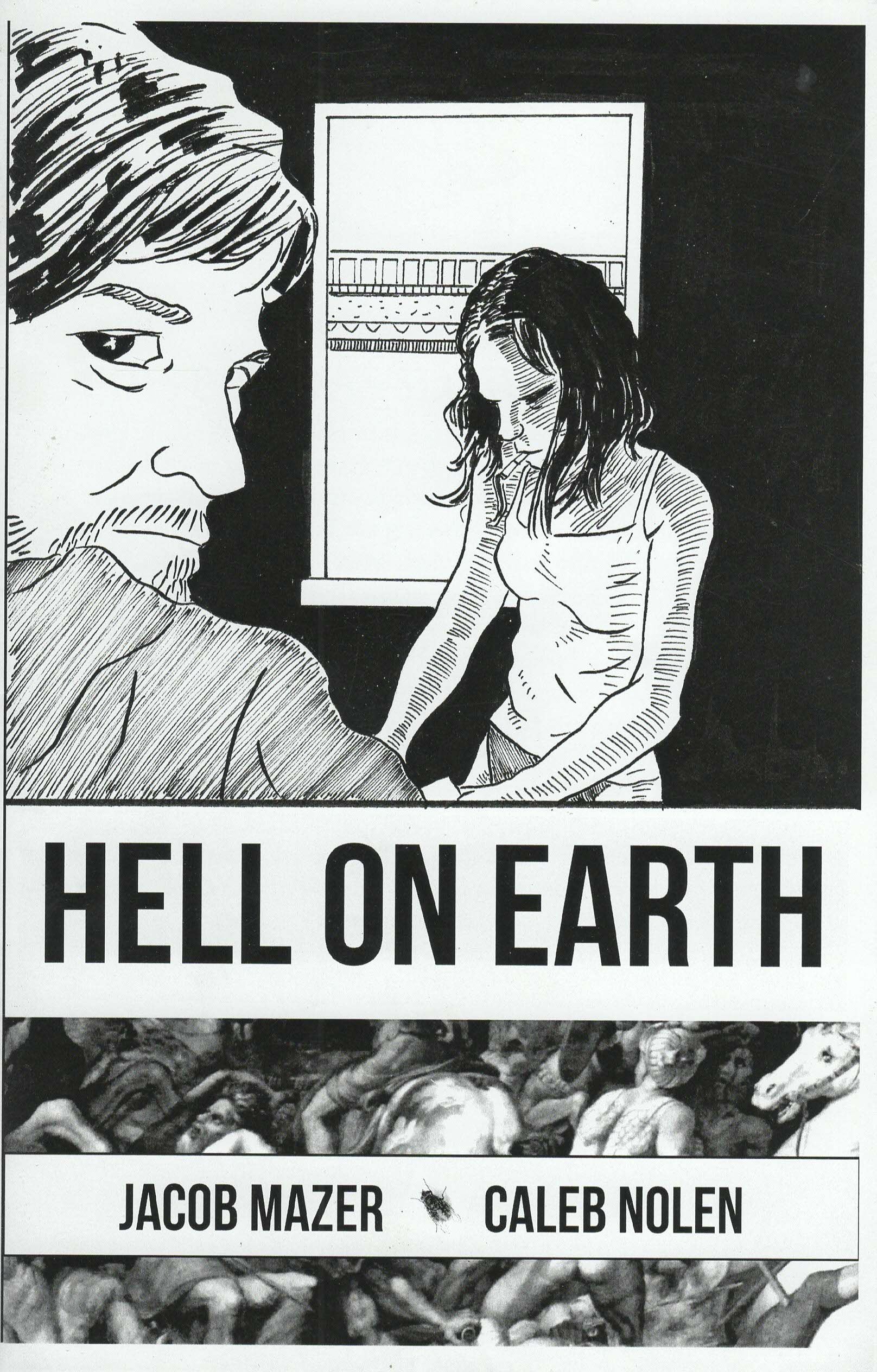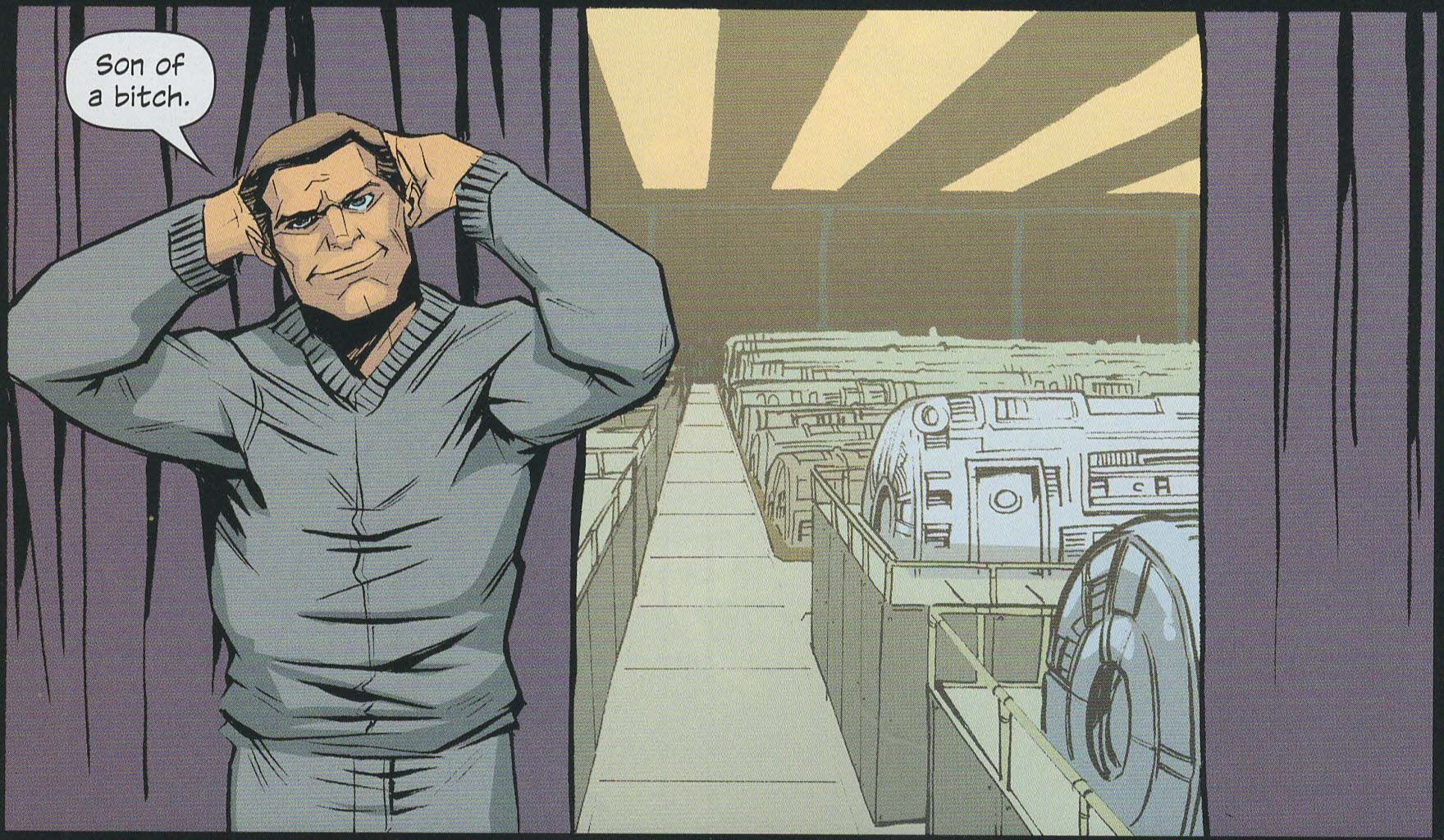"At the end of the twentieth century, we are trying to separate inseparable strands, to divide this one from that one, because this one may be Macedonian and that one may be Bulgarian ... Here the men sit back like the old men of Crete, talking about nationalism and hate while the women do all the work." (Robert Kaplan, from Balkan Ghosts)
Ei8ht #1 by Rafael Albuquerque (story/artist/colorist), Mike Johnson (story/scripter), Nate Piekos (letterer), Spencer Cushing (assistant editor), and Sierra Hahn (editor). $3.50, 22 pgs, FC, Dark Horse.
Rafael Albuquerque is a really good artist, so Ei8ght looks great, even with the silly title. Albuquerque uses nice thick lines to add heft and toughness to the art, all without sacrificing the smooth action that he's famous (?) for, and the result is a gritty comic that remains sleek, which is a difficult and unusual combination, but which works nicely here. The book takes place partly in a somewhat seedy future and partly in a world where technology seems to sit uneasily alongside squalor, so Albuquerque's abilities here lend both places a good veneer of authenticity. We've seen seedy futures and semi-barbaric places where people ride dinosaurs but still build tall spires before, so the fact that Albuquerque is able to bring both of those settings to life pretty well is appreciated. His characters dominate the book, though, as we meet our protagonist, Joshua, who has been dropped into a place called the Meld in a spaceship (it seems like he traveled through time, so maybe it's a "timeship"?). There he loses his memory to a degree (so that he needs to be reminded of the significance of "8" in the issue, but if you don't think it's going to have something to do with infinity before this series ends, I have a nice bridge to Brooklyn to sell you) and meets up with some unsavory types from the Meld, who take him captive. Albuquerque makes Joshua a fairly milquetoast kind of guy, which makes his rage at times in the book seem even more ineffectual, while the Meld inhabitants are much more confident and poised, even if they do look like they could easily step into a Mad Max movie at any moment.* Albuquerque's colors are quite nice, even though the color code at the beginning of the issue annoys me more than I thought it would. Shouldn't we be able to figure out the color code? Anyway, he uses the blues and yellows of the Meld well, punctuating both its reality and the world of the future where Joshua begins with reds, which pop well. The oversaturated colors bug me these days when they're used in television or movies, but they're really perfect for certain comics, and Albuquerque uses the wisely. They remind me of early Casanova, actually, before the Marvel recoloring.
You'll notice I haven't written much about the story. It's ... serviceable. Joshua climbs out of a crash with a fuzzy memory of what he's doing there, but he slowly remembers a little before he's attacked by the "savages." In the future, some scientist has made a deal with him, and he's a test pilot, it seems. In the Meld, there are the aforementioned people, some dinosaurs, and an SS officer. Joshua is looking for the SS officer, but we don't know why yet. Said SS officer shows up at the end as the "Spear" of the "Tyrant," and he finds Joshua's ship and orders his minions to find Joshua. So yeah, things are afoot. It's entertaining but nothing too challenging. But that's okay. It looks nice.
Ei8ht is a five-issue mini-series, so I wouldn't be surprised if a lot of people waited for the trade, and I probably should, too. The ways trades are priced these days, however, sometimes it's just more fun to get the single issues. This is a nice beginning, so we'll see where Albuquerque and Johnson go with it!
* I'm sure anyone who wants to has already seen the trailer for Mad Max: Fury Road, but here's a link. Holy shit, it looks so freakin' awesome I can barely stand it, and as you know, I'm very jaded about big-time action movies anymore. But I feel like a giddy 15-year-old when I watch that trailer.
Rating: ★ ★ ★ ★ ★ ★ ★ ☆ ☆ ☆
One totally Airwolf panel:
Rocket Salvage #3 (of 5) by Bachan (artist), Deron Bennett (letterer), Jeremy Lawson (colorist), Yehudi Mercado (writer), Alex Galer (assistant editor), and Rebecca Taylor (editor). $3.99, 22 pgs, FC, Boom! Studios/Archaia.
I got the first issue of Rocket Salvage on a lark, because the art looked nice, but it's turned out to be a pretty fun series. Again, with the way Boom! releases their trades these days, there's no guarantee this will be out any time soon and that it won't cost the same as getting the issues, so why not get the issues? It's LOGIC, fools!
Rocket Salvage has been a blast so far, as our hero, Primo, tries to run from his past as a disgraced racer and keep a secret from his "daughter" (who's really one of his clones) about her true nature. In this issue, we find out what she can do, and it's pretty impressive. There is, just like Ei8ht, nothing ridiculously unique about the story, but as I've often noted, it's more in the way it's told than what is being told. Mercado makes the characters interesting - Primo is still a bit of a hotshot, but because he's older and wiser, he's not as reckless as he used to be, while Zeta, his "daughter," is kind of a bitch. Beta, Primo's older clone, is literally a reject that Primo saved, and while he's not as smart as Zeta, he's much nicer and not afraid to call her on her attitude. So there's a nice family dynamic going on in the book that makes the stakes feel higher. We know the betrayal at the end of the issue is coming, so it's not surprising, but what is surprising is the way Beta is unwilling to put up with his "sister." It makes their relationship feel more real, because there are actually consequences to their behavior.
Meanwhile, Bachan's art is terrific - he bends and twists his characters in all sorts of ways, giving them wonderful expressions as they try to fight against the bad guys and navigate through some serious space stuff. His kinetic style is perfect for a book where the action is almost non-stop, and even when it slows down a bit, the characters are still bouncing off the walls, it seems, because things of import are happening! Lawson's colors are wonderful, too, as he uses bright colors to match the craziness of the line work, making space less of a void and more of a crazy adventure. Bachan uses jagged lines to show energy quite often in this book, and Lawson colors them in eye-popping primaries, and the effect just makes the book feel far more fun than some of the gloomier stuff that we often see in, say, superhero comics (although that has been changing recently, which is nice). It's a fun book to look at as well as read.
Again, I'm sure plenty of people are waiting for the trade, which is fine, but you should give this a look. I don't know how it's going to end, but it's been pretty keen so far!
Rating: ★ ★ ★ ★ ★ ★ ★ ½ ☆ ☆
One totally Airwolf panel:
The Fuse #10 ("Gridlock Part 4"/"Tabloid Part 4") by Shari Chankhamma (colorist), Ryan Ferrier (letterer), Justin Greenwood (artist), Antony Johnston (writer), Mack Chater (artist, "Tabloid"), Ian Mayor (writer, "Tabloid"), and Abby Ryder (colorist, "Tabloid"). $3.50, 23 pgs, FC, Image.
Man, I hate when comics are right in the middle of story arcs. What can you write about them? You're either on board with The Fuse or you're not. Antony Johnston isn't re-inventing the wheel here - he's telling murder mysteries, and while the setting allows him to do some interesting things - like this arc revolving around an illegal sport that could only occur in outer space - it's not like he couldn't have written a crime about an underground sport set on Earth. Johnston is one of those quietly excellent writers, in that he doesn't do flashy stuff (you could argue that Umbral is fairly flashy, but if it is, it's the first "flashy" thing he's written) but he creates compelling characters very quickly and puts them in interesting situations. Klem and Ralph have their mysteries, but they're good characters, and Johnston writes them well alone and together, and he gives them unusual cases to solve that touch on all parts of the society of the Fuse. Johnston has been developing the world of the Fuse for a long time, so he's had time to figure out the way its society functions, and it shows. So while he certainly could have set in on Earth, the added bonus of the sci-fi touches make it even more clever than it already was.
So things are happening, people are questioned, and another body shows up. All in a day's work for our intrepid cops! Johnston and Greenwood just keep on keeping on, and as always the tenth issue of The Fuse is as solid as the first nine. It's shocking!
Rating: ★ ★ ★ ★ ★ ★ ★ ½ ☆ ☆
One totally Airwolf panel:
Silk #1 by Ian Herring (colorist), Travis Lanham (letterer), Stacey Lee (artist), Robbie Thompson (writer), Devin Lewis (assistant editor), Ellie Pyle (editor), and Nick Lowe (editor). $3.99, 20 pgs, FC, Marvel. Silk created by Dan Slott and Humberto Ramos. Spider-Man created by Steve Ditko and Stan Lee. Felicia Hardy created by Marv Wolfman and Keith Pollard.
As with a lot of Big Two comics, I like to try the first issue even if I'm pretty sure I'm going to wait for the trade. DC has been pretty good about keeping their books at 3 dollars, so I'm more inclined to buy those in single issues, as Marvel keeps jacking up their prices. I mean, 4 bucks for 20 pages? Really, Marvel? I will bet one shiny nickel that Joey Q. lights his cigars made of Benjamins with other Benjamins as he wonders whether his suit should be encrusted with diamonds, opals, sapphires, or what-the-fuck-let's-go-for-the-trifecta because of all that movie money that's rolling in, yet he's still trying to squeeze every last penny out of the readers of his comics. The instant Ms. Marvel goes up to $3.99, I'm dropping it like it's hot, and then I will buy no Marvel single issues. But I still want to check out their stuff before deciding if I want to get the book in trade, so I'll get the first issue. I'm still mulling Squirrel Girl (I didn't think it was adorkable as many Internetters did, but it was pretty decent), and now we get Silk, because what the world really needs is more Spider-Man-related titles. How is this going to be any different from Spider-Gwen?
Of course, it's a pretty good issue. Thompson gives us a goofy villain called Dragonclaw who's part of a more sinister agenda even though he's completely inept, and Cindy Moon - our hero - is nicely done, full of insecurities in the flashbacks to her teenage days and charmingly clueless (see below) in the present after spending ten years in a bunker (which strains credulity, but that's okay - it's superhero comic, after all). Her inner monologue isn't great, but it's not grating either*, and we get a reasonably interesting mystery about her past. I'm trying not to damn with faint praise, because the book is entertaining, and "breezy" shouldn't be a pejorative adjective, but that's what it feels like. Even with the mystery of the bunker, the fact that Cindy inexplicably tells her mother she hates her in one of the flashbacks (she really went quickly to the "I hate you" line, it seems), and a few odder plot points (which I'll get to), the book feels breezy. Perhaps that's more to do with Lee's art, which is somewhat Becky Cloonan-influenced, which means it's very welcome on a Big Two comic. Lee's quite good at the action scenes, and her work with Cindy and Peter's body language when they talk to each other is well done. As usual with a lot of artists who don't start off in superhero comics, she's very good at making her characters look like real people, from the way the look, act, and dress (when they're not in uniform). Lee's art is refreshing, I would call it, and it adds to the somewhat light-hearted tone of the comic.
Which is why the two things that bug me about the issue do bug me. I didn't read Cindy's first appearances, so I don't know what the deal is with her and Peter, but when she mentions they had a "thing," it kind of skeeved me out a little. I have no idea why. Maybe it's because she's a new character who's been retconned into his origin, so technically they're the same age, but she seems younger than Peter and more of a protégé and he a mentor, so them having a "thing" seems odd.** It's probably just me, but it bugged me for some reason.
Second, there's the Black Cat. She shows up as Dragonclaw's boss, and she seems quite evil. I've always liked Felicia, and while she's been a "bad guy," she's never been actually evil, has she? Now she's a crime boss and there's a serious implication that she's about to have something horrible done to poor inept Dragonclaw? Is that a thing in the Spider-verse these days? If it is, Greg no like. Can't someone just be a rogue-ish villain without turning all dark and scary? Anyway, that bugged me too, but for different reasons. If Slott has turned her into a darker figure these days, I might not like it, but at least it's explained elsewhere. This Felicia seems completely out of character.
Anyway, I read the first issue. It was pretty good. I may get the trade, but I won't buy the single issues!
* Check out that wordplay!
** I saw a link on Facebook to an article, the first sentence of which mentioned the "mentor/mentee" relationship. Are we really okay with calling a protégé a "mentee"? The fall of civilization continues apace!
Rating: ★ ★ ★ ★ ★ ★ ★ ☆ ☆ ☆
One totally Airwolf panel:
She-Hulk #12 by Clayton Cowles (letterer), Javier Pulido (artist), Charles Soule (writer), Muntsa Vicente (colorist), and Jeanine Schaefer (editor). $2.99, 20 pgs, FC, Marvel. Jennifer Walters created by Stan Lee and John Buscema. Patsy Walker created by Ruth Atkinson. Herman Schultz created by Stan Lee and John Romita, Sr. Vibro created by Denny O'Neil and Luke McDonnell. Doctor Druid created by Stan Lee and Jack Kirby. Tigra created by Tony Isabella and Don Perlin (sort of). Monica Rambeau created by Roger Stern and John Romita, Jr.
I'm not a huge fan of comics creators writing text pieces in the back of canceled series (when it's the end of a run they planned, that's something different), and Charles Soule's text piece in the back of the final issue of She-Hulk is why. Soule seems like a nice guy; I've only met him once, but he was very friendly (yes, it was at a convention and he was obviously trying to sell his work) and, like a lot of comics creators, he liked talking shop. So I shouldn't have any reason to doubt his text piece at the back of this book ... but it seems a bit disingenuous. I'm sure Soule pitched a version of these twelve issues, and he points out in the text piece that it's the final part of a twelve-issue story and that he "pitched what [we] read." Well, possibly. The final two issues felt awfully rushed, though, didn't they? Soule knew the book was canceled, and it just felt like he wanted to get the main mystery - that of the Blue File - out of the way. Soule still wants to get work from Marvel, so there's no way he's going to bite the hand that feeds him, and that's cool. I just wonder if the mystery of the Blue File was either something he wanted to clear up sooner but decided against it once it became clear the book was going to get canceled, so he put it off until the final two issues; or if he wanted to tease it out longer but couldn't because the book was getting canceled. The structure of the series doesn't feel right, though, as good as it was. The Blue File felt like something that could have been cleared up earlier and then Soule could have moved on from it, or something that was hanging over Jen and her associates for far longer than it was. Soule probably did pitch a version of this story - there's no reason to think he didn't - but it just feels like the pacing of the entire series was off somehow. I don't know when Marvel decided to cancel it, but if it was around issue #6, that could have significantly changed the direction of the series. Soule couldn't not resolve the Blue File, even though it felt more momentous than what it turned out to be. It's a good idea, but it didn't feel like it had the impact Soule wanted it to have. That's one reason why I don't like text pieces at the end of issues. Unless the writer is leaving comics forever, there's no way he or she is going to be completely honest. That would be career suicide.
Anyway, it's a nice little twelve-issue series, and it's too bad it didn't find an audience. The vagaries of the marketplace continue to stymie its observers!
Rating: ★ ★ ★ ★ ★ ★ ★ ½ ☆ ☆
One totally Airwolf panel:
The Multiversity: Mastermen ("Splendour Falls") by Jeromy Cox (colorist), Jonathan Glapion (inker), Sandra Hope (inker), Mark Irwin (inker), Jim Lee (penciller), Rob Leigh (letterer), Grant "Yep, it's Underwaterman, because I'm Grant Fucking Morrison!" Morrison (writer), Alex Sinclair (colorist), Scott Williams (inker), and Rickey Purdin (editor). $4.99, 40 pgs, FC, DC. Overman created by the God of All Comics and J.G. Jones. Leatherwing created by G-Mozz, Justin Gray, and Fabrizio Fiorentino. The JL-Axis created by the GoAC, Justin Gray, and Trevor Moore.
When this issue was solicited, I wondered if Morrison specifically wanted Jim Lee to draw the story about the Aryan supermen ruling the world because of Lee's style, which tends to make everyone look like Aryan supermen (which is odd, considering Lee's ethnicity), and in this issue, we get a nice representation of Aryan supermen, so I'm wondering it even more now.
As Multiversity hurtles along, I find myself wondering more and more about the grand design. Sivana, of course, has appeared as kind of a big villain, although it's clear he's working for someone else, and I assume Morrison will address that as it goes along. But will we return to Earth-10, even for a page or two, to see how the events of this issue have changed the world? Morrison, of course, is famous (infamous?) for jumping around like crazy when he has to pull things together, and it usually works, so I imagine we'll return to these Earths in the final issue, but it's just something that's been bugging me. Especially in an issue like this one, which is okay but hardly the highlight of the series. The only thing remotely interesting in this comic is that Sivana funds the Freedom Fighters and we know that Raiders of the Lost Ark doesn't exist in this world or Uncle Sam would never trust Sivana, who's basically this dude. Come on, Uncle Sam, check out some pop culture while you're fighting against Overman and his crew! Lee's art is its typical late-era Lee, in that it's fairly sketchy, while Cox and Sinclair, who are perfectly fine colorists, chose early on to go with gun-metal gray as their base and never looked back. It fits the tone of the comic, certainly, which is the point. But overall, it's just a somewhat dull chapter in a bigger epic, so we just have to grit our teeth and deal with it. It happens.
Next up is the Mahnke-drawn issue. I'm looking forward to that a lot more than I was to this one!
Rating: ★ ★ ★ ★ ★ ★ ☆ ☆ ☆ ☆
One totally Airwolf panel:
Ms. Marvel #12 ("Loki in Love") by Elmo Bondoc (artist), Joe Caramagna (letterer), Ian Herring (colorist), G. Willow Wilson (writer), Charles Beacham (assistant editor), Devin Lewis (assistant editor), and Sana Amanat (editor). $2.99, 20 pgs, FC, Marvel. Loki created by Stan Lee, Larry Lieber, and Jack Kirby.
I'm not entirely sure why Loki shows up in this issue. Is Loki that big a draw that his presence will raise sales on the book? Is Kamala such a draw that people reading this comic will think that they really need to check out that Loki book over there on the shelf (the new issue of Loki came out this week, but of course it's $3.99, so I dropped it in favor of trade-waiting)? It's a pretty random combination (much like the Wolverine appearance a few issues ago; if Ms. Marvel is selling so well, why does it need guest stars?), and honestly, this is almost the true definition of "filler," as nothing really happens. I mean, Loki tries to help Bruno express his crush on Kamala, and Loki adds truth serum to the punch at the school dance (which Bruno, much to his relief, doesn't drink), and Kamala gets to fight Loki, but it's an utterly pointless issue. It's fun to read, sure, because Wilson is doing a nice job with these characters and everyone, it seems, relishes a chance to write Loki these days (I blame Tom Hiddleston), so it's not a bad issue, but it does feel completely inconsequential. Issue #11 came out two weeks ago, so it's not like Marvel had to rush it out - they haven't been double-shipping this comic (that practice seems to have gone by the boards at Marvel to a large degree, which is nice), and while it appears issue #11 was a bit late (no issue came out in January) and they needed a guest artist, Wilson didn't have to write such a slight tale. I'm all for stories in which very little happens, especially if they're written well, but the reason this issue irks me is because it's set up as a consequential one - ooooh, Loki has to check things out and that will lead to mischief! - but then it's not. Wilson should have ditched Loki and made the entire issue about Bruno's pathetic yearnings for Kamala and how he plans to man up until the very end, when he chickens out.* That would have been an interesting comic. This is fun, but very slight.
Oh well. Life goes on.
* In the recent attempts to invert the old sexist trope of girls pining for boys they're too scared to approach, Bruno joins a wave of boys who are yearning for girls they're too scared to approach. These kinds of storytelling clichés fascinate me. I don't know how old Bruno is supposed to be (has it been stated in the comic?), but Kamala is 16, so let's assume that Bruno is too. I started dating at 16, because prior to that I just was too interested in enjoying life to get caught up with girls. I have never had much game, but these dudes in comics and television - Barry Allen, I'm looking at you** - are just really pathetic. I know it's supposed to increase the stakes because the girl inevitably goes off with some other dude and then the boy can pine away for her even more, but I really hope Wilson doesn't drag this on too long. Nut the fuck up, Bruno, and ask Kamala out on a date!
** I should mention that I've only watched up to the Arrow crossover on The Flash so far, so maybe since then Barry has gained some confidence and has by now participated in an orgy with Iris, Caitlin, and Felicity, which would make my point moot ... but I kind of doubt he has.
Rating: ★ ★ ★ ★ ★ ★ ½ ☆ ☆ ☆
One totally Airwolf panel:
Secret Identities #1 by Ed Dukeshire (letterer), Jay Faerber (writer), Brian Joines (writer), Charlie Kirchoff (colorist), and Ilias Kyriazis (artist). $3.50, 28 pgs, FC, Image.
I actually own the first 6 (or maybe 7) issues of 7 Guys of Justice, Brian Joines's claim to fame (?), although I had completely forgotten it was his series until he reminded readers at the end of this issue. So look at me, being all underground and shit!
I got Secret Identities not because of Joines (sorry, sir!) but because of Faerber, as Faerber is currently one of the best superhero writers in comics, even if people trapped in the Big Two Paradigm (which was the name of my prog-rock band in college) don't know about it. Faerber's been stretching his creative muscles recently, but he's still just damned good at writing superheroes, so when I saw that he was doing a new superhero book, I knew I'd pick it up. Joines has a pretty good handle on the oddness of superheroes, too, so they will probably make a good team. And this first issue is pretty great, even as Faerber and Joines tend to stick to the script of introducing the team in battle, introducing a new hero who is welcomed into the group, and then showing the individual members going about their lives. It's not a spoiler to say that the new member - Crosswind - has infiltrated the group - the Front Line - in order to destroy it, as that was part of the solicitation and, I mean, come on - he's standing in shadow on the cover! It's obvious! What is a surprise is who he's working with, although as it's the first issue and we don't know the characters very well, it doesn't have that much of an impact. But it's still a bit surprising. Even though it's a fairly standard first issue, Joines and Faerber are smart enough to play with our expectations a bit. So when the heroes go off to their own lives, we see how unusual they really are, even if they're heroes. Of course, the writers are doing this so the potential for scandal are heightened and as Crosswind investigates, I'm sure he'll find plenty of juicy things to keep him occupied, but it also shows, as usual, that Faerber thinks about how superheroes would act out of costume and what their "civilian" lives would be like. That they're so fraught with tragic potential isn't surprising, but that doesn't mean they're not logical from the perspective of who these people are. Joines and Faerber know how to structure a book, so that we get quite a lot in this book - the initial fight, Crosswind's intervention, a brief look at all the other heroes, Crosswind's first visit to the Front Line's headquarters, and then the second reveal of the person with whom Crosswind is working. It's a smoothly effortless first issue (I know it took effort, but it feels effortless), something Faerber has been doing for about 14 years now, and I don't know how much is him and how much is Joines, but it's clear they both know what they're doing.
Faerber has also been able to find great artists, especially from outside the country, and that streak doesn't end with Kyriazis, whose work on this issue is tremendous. He has a fluid line that makes the action scenes work really well, and his layouts are excellent, as he has a lot of information to get into this issue. During the fight, his layouts are a bit more interesting, and he sticks to standard quadrilaterals when we get to the introductions of the various characters, contrasting their "civilian" lives with the more dynamic public lives they lead. His character designs are terrific, and the way he draws the figures leaping around the page during the fight is very nice, as are his quieter moments when the characters need to "act" more. Yes, the heroes are based on tropes, but that's true about pretty much every superhero, so I don't hold that against the creators. Kyriazis does good work with Crosswind, too, as he goes from a wide-eyed idealist to a far more disturbed character convincingly, even though Kyriazis gives him freckles and therefore keeps him incongruously adorable-looking, so he looks a bit like Evil Jimmy Olsen. Kirchoff's coloring is very nice, too, as the book is nice and bright, although I'm not sure why, during the fight, Gaijin (whose name is somewhat odd, I admit) is colored bright orange but then she becomes blue when she stops. I assume there's a reason for it, but right now, it's a mystery and I really hope it wasn't a mistake. We shall see.
I'm pre-disposed to like Faerber's work, I know, because of his track record, but Secret Identities is still a really good issue. It sets up most of the premise (we don't know why the bad guys are plotting, after all) and introduces a lot of characters very well. It looks great. It's longer than your usual issue! Give it a look!
Rating: ★ ★ ★ ★ ★ ★ ★ ★ ☆ ☆
One totally Airwolf panel:
13 Coins #5 by Simon Bisley (artist), Martin Brennan (writer), Ryan Brown (colorist), Michael B. Jackson (writer), David Withers (colorist), and Tom Williams (editor). $3.99, 24 pgs, FC, Titan Comics.
I assume 13 Coins will end next issue - it was solicited in November and nothing has been offered since, and I can't remember if it was listed as the end of the series, but I'm going with it - which is strange, because it doesn't really feel close to ending. Perhaps it's one of those "This series will end with the low-level bad guy getting defeated, but the high-level bad guys will still be around!" kind of things, which is fine, but I do wonder how everything will play out. John, the protagonist, has just now accepted his entire legacy, and even that's still a bit dicey. I guess we'll see.
I haven't loved this comic, which is too bad. I was interested in it because of Bisley's art, which I dig, and as I mentioned a few weeks ago, it's better here than it is on The Tower Chronicles, although it could still be crisper. I've always liked Bisley's combination of cartoonish figures and horror, and we're getting that here, so while some of it's a bit sloppy, for the most part it's nice to see. The story, however, isn't really grabbing me. It feels a bit perfunctory, as Brennan and Jackson go through the motions of awakening John to his true nature and presenting evil threats for him to battle. There's a bit of a nice swerve in this issue, as Brennan and Jackson actually have someone go through with a fairly horrific act, but overall, I'm not really taking a shine to the series. I'm curious how it will end, though, so I'll write a bit more next time.
Rating: ★ ★ ★ ★ ★ ★ ☆ ☆ ☆ ☆
One totally Airwolf panel:
The Autumnlands: Tooth and Claw #4 by Jordie Bellaire (colorist), Jimmy Betancourt (letterer), Kurt Busiek (writer), Benjamin Dewey (artist), and John G. Roshell (letterer). $2.99, 24 pgs, FC, Image.
I'm still getting the feel for this series, even though I'm enjoying it. Dewey and Bellaire, of course, are killing on it, as Dewey brings all the various animals to life and Bellaire's soft-focus coloring work evokes nostalgia even though this seems to take place in a post-apocalyptic future. Dewey really gets the personalities of the animals, both as they've been revealed and even as we think of animals - Dusty appears more faithful not only because of the expression that Dewey draws on him, but because he's a dog, while Dewey's shrewd and conniving Goodfoot fits very well with the fact that she's a coyote. It's well done.
We're four issues in, and while Busiek's story is perfectly clear - the animals believe Learoyd will help them, but some of them don't trust him and even the ones who do are mystified by what he's doing, while we're not really sure what he's doing either - I'm still trying to figure out if it's worth pursuing. Some books grab you by the throat and don't let go, but Busiek has never really been that kind of writer. He tends to ease us into things, and while the first issue of this series did have some flash, it promised a really long-range kind of story, so it comes down to whether you trust Busiek or not. I do, so I'm willing to give him time. He knows how to pace things, so each issue has given us a bit of action and a bit more about the characters and what they're doing, and I'm perfectly willing to be patient. I just don't quite know what's going on yet beyond the basics - Learoyd is figuring out how to keep the animals safe, but beyond that, who knows; Sandorst is a big jerk; Goodfoot cares only about profit - but it's clear that Busiek does. So I'm just going to keep buying for a while, and we'll see what shakes out.
(I will say that while Dusty is the narrator, certain events happen in this issue that he doesn't see, and that bugged me more than it should. Busiek has already done this in the series, and each time, it bugs me. He mentions in the letter column that they'll shift narrative perspective occasionally, which gives him this "out," but for some reason I don't like it. It seems to make Dusty less important as a character, even though putting him in a place to witness the back-room deals would strain credulity. I don't know - I'm just rambling. But it does bug me.)
Rating: ★ ★ ★ ★ ★ ★ ★ ½ ☆ ☆
One totally Airwolf panel:
Plunder #1 (of 4) ("Still the Waters") by Deron Bennett (letterer), Swifty Lang (writer), Skuds McKinley (artist), Jason Wordie (colorist), Chris Rosa (assistant editor), and Rebecca Taylor (editor). $3.99, 22 pgs, FC, Boom! Studios/Archaia.
One of the reasons I don't like horror movies is because of the utter stupidity of the characters (which that Geico commercial parodies quite well). There is absolutely no reason for most horror movies to occur, yet the people in them keep acting like idiots, and it takes me right out of the story. The metaphorical (or even literal) equivalent of "nuking it from orbit (as it's the only way to be sure, naturally)" is the only solution to about 99% of horror movies - just get out of there and napalm everything within five square miles, and everything should be all right. Writers are aware of this fault and try to mitigate it with explanations, but they're usually not very good. It's just something you have to accept if you're going to read horror fiction: people are going to act like idiots in it.
Which brings me to Plunder, a new horror comic. Writer Swifty Lang (not his real name, unfortunately, which is also the case with artist Skuds "Not His Real Name" McKinley) tries to make it logical that the characters would hang out on a submarine that is obviously not healthy for them by making them Somali pirates, who are tough guys (which is one way writers mitigate the characters' idiotic moves) with an economic motive for going aboard a strangely quiet ship (which is another decent reason for it, although it still doesn't excuse them completely). Lang does manage to make one of the characters sympathetic - the young neophyte whose father is dead and who yearns for a life beyond his small village but isn't a terribly good pirate is the narrator - and he does make the pirates interesting, so there's that. But even though they think they're tough guys, when they climb on board a submarine that's just floating above the water and the first thing they find is an arm hanging from a door, as if someone was desperately trying to get inside and his body got ripped away from the arm, the idiocy begins! They naturally think another group of pirates has gotten to the boat first, even after they find another body and one of their number actually says that "people don't do this." As with many horror stories, the only thing that might excuse it is that people in horror stories apparently live in a world with no pop culture horror stories (post-Scream, this isn't as prevalent an idea, but it's still dominant), so they don't even consider that whatever killed the crew might not be human, but that's pushing it. If I got on board a submarine and the first thing I found was an arm hanging from a door, I don't think I'd open that door and head inside. Of course, I wouldn't become a Somali pirate, either.
McKinley does good work with the characters, turning them into a true motley crew of reprobates, and while I doubt if we'll get much about the circumstances of their lives (they're all obviously damaged in either obvious or less obvious ways), that might be interesting, as we don't get to read many comics about Somali pirates (Lang can do that; the only other comic by him that I've read, Feeding Ground, managed to blend horror with the problem of illegal immigration across the U.S-Mexican border pretty well). Lang only has four issues to work with, so he has to get to the action, and McKinley does well with the gore and the terror that the characters are already feeling. The book is set up well, and it looks nice, so the only question you should be asking is:
Can you deal with idiots? If you can, then you should give it a look. It's a good start.
Rating: ★ ★ ★ ★ ★ ★ ½ ☆ ☆ ☆
One totally Airwolf panel:
Terminal Hero #6 (of 6) by Simon Bowland (letterer), Kelly Fitzpatrick (colorist), Piotr Kowalski (artist), Peter Milligan (writer), Hannah Elder (associate editor), Molly Mahan (associate editor), and Joe Rybandt (editor). $2.99, 22 pgs, FC, Dynamite Entertainment.
I'm disappointed by Terminal Hero, mainly because Milligan kind of chickens out. As soon as Rory got himself a wife and kids by "becoming" someone else, I feared that Milligan might tone it down a little. Sure, there's death and sex in this issue, but it never feels like the stakes are too high because nothing that Rory cares about is really threatened. I'm not necessarily one of those people who thinks that you always have to put innocent people in jeopardy to raise dramatic stakes, but Milligan has always shown himself to be fearless about pushing envelopes, and in this series, it felt like he teased that a lot without really doing so. Rory doesn't really go on too weird a journey, and Mia and Minesh, the two people who also have his powers but without his moral compass, never really rise to a level of threat to him and even when they try to get him to join them (which leads to the aforementioned sex), it feels too clinical and I never got the sense that Rory was considering it. Milligan does tend to be an arch writer who examines artifice rather well, but in this series, it felt like he was trying to dig deeper into Rory's psyche but couldn't shake off his bemused detachment. Milligan, obviously, has written deeply emotional characters in the past, so it's not like he can't do it, but in this series, it seemed like he was toying with that but either couldn't pull it off or kept pulling the rug out from under us just for the hell of it. This climactic issue has two of them, but neither feel terribly climactic or all that earned, even. It's frustrating.
Kowalski's art is nice, though. Apparently he's the go-to guy to draw your orgy these days. That's a niche.
Rating: ★ ★ ★ ★ ★ ½ ☆ ☆ ☆ ☆
One totally Airwolf panel:
Rumble #3 by John Arcudi (writer), Chris Eliopoulos (letterer), James Harren (artist), and Dave Stewart (colorist). $3.50, 25 pgs, FC, Image.
The first issue of Rumble was almost completely incoherent. (Over at Savage Critics, Abhay has been doing "inquisitions" of comics - really in-depth looks at certain ones - and he, well, savages Rumble #1. I wasn't quite as down on it as he was, but as Abhay is smart, I don't disagree very much with him on this.) Issue #2 was only slightly less so. It wasn't a charming kind of incoherence, where it's clear the writer is doing it to create a good sense of mystery. I mean, I know that's what Arcudi was doing, but for me, at least, he was failing. There wasn't anything particularly intriguing about the book, especially issue #1. I decided to stick with it until the end of the first arc, mainly because I like Harren's art and Arcudi has, after all, written some good comics in the past. I lived in hope!
Arcudi begins to answer some questions in issue #3, which is nice. We learn a lot about the scarecrow who showed up in issue #1, as we find out that he's the spirit of an ancient god who was trapped in a prison for millennia until his overdue release. There are still problems with the comic - the two main human protagonists aren't very compelling, Rathraq's mission is largely inconsequential, and the bad guy doesn't seem to have any reason to be bad, except for, you know, wanting to watch the world burn. There are almost zero fucks to be given about what happens to anyone in this comic book. I guess Del is funny? Yeah, funny guys are a dime a dozen. Maybe that will change. Maybe it won't.
Harren's art continues to be the reason to buy the book, as he begins the issue with wonderful drawings of Rathraq and his war hound kicking ass and then does a terrific job later when Kaggahn traps Rathraq in a "soul net." His flashback drawings are full of power, both in the figures and in the landscape, and they're contrasted well with Bobby's weak-chinned wuss and Del's big galoot-ness. Even the prison in which Rathraq is trapped is impressive, as Harren makes it impossible, a column of rock hanging down from an unknown roof, rough-hewn and impassive in the face of its prisoner. His designs of the gods and monsters is wonderful, and Stewart's marvelous colors (no shock there) add nice nuance to the line work and make Rathraq's world even more solid and dominating, while the "real" world of Bobby and Del is far too muddled and dull. Presumably Harren and Stewart are trying very hard to contrast Rathraq's manly world with Bobby and Del's wussified world, but given that Bobby will either end up with Timah or avenge her bloody death (that is, assuming Arcudi doesn't take the even more standard route and follow Pop Culture Rule #1), perhaps they shouldn't try quite so hard. We'll see, I guess.
I'm still getting this for two more issues (I think that's the end of the first arc), and I'll decide about it then. I certainly hope it gets better, but at least now we have some answers!
Rating: ★ ★ ★ ★ ★ ★ ☆ ☆ ☆ ☆
One totally Airwolf panel:
Lumberjanes #11 ("Go Ball-istic") by Aubrey Aiese (letterer), Maarta Laiho (colorist), Carolyn Nowak (artist), Noelle Stevenson (writer), Shannon Waters (writer), Whitney Leopard (associate editor), and Dafna Pleban (editor). $3.99, 22 pgs, FC, Boom! Studios.
As fun as Mal and Molly's adventure in the other dimension is and as nicely their insecurities about themselves are brought up, you know the best part of this issue is back in camp, where the rest of the gang are trying to get mundane patches and failing spectacularly. Ripley manages to get a few, but Jo and April failing at everything because their personalities fit crises much better than "normal life" is excellent. As this is a kid-friendly comic, the idea of being great at something that requires a particular set of skills but not being able to adjust to "normal life" isn't as depressing as Bradley Cooper not knowing how to hold a fake baby, but it's still an interesting comment on how these girls deal with things that aren't mythological creatures bent on dominating the world. It ties in nicely to Mal and Molly's conversations in the other dimension, and while it's a common idea in fiction, it's handled well here and it's something that I'm not sure is as common in Young Adult/Children's literature. The way that Stevenson and Watters introduce is done well.
Plus, the issue is freakin' hilarious as always, and while I don't like Nowak's art quite as much as Brooke Allen's, it's still pretty good. I continue to dig Lumberjanes so much, and my daughter really digs it too, so that's nice. It's fun for the whole family!
Rating: ★ ★ ★ ★ ★ ★ ★ ★ ☆ ☆
One totally Airwolf panel:
Batgirl #39 ("Batgirl vs. Burnside") by Brendan Fletcher (writer), Jared K. Fletcher (letterer), Cameron Stewart (writer/breakdowner), Babs Tarr (artist), Maris Wicks (colorist), Dave Wielgosz (assistant editor), and Chris Conroy (editor). $2.99, 20 pgs, FC, DC. Barbara Gordon created by Gardner Fox and Carmine Infantino. This Black Canary created by Denny O'Neil and Dick Dillin.
I actually had the original cover first, but it's kind of boring, so I caved and bought the Harley Quinn variant. For a DC or Marvel comic, that might be a first, as usually my retailer immediately jacks up the price on any "true" variant, but I guess for the Harley Quinn ones, he got so many that he just put them out for the unwashed heathens who don't want to pony up five bucks for a black-and-white version of a random cover. So I got this cover!
I don't wish to alarm you, but according to issue #38, Barbara is currently 21 years old. That means she became Batgirl, was shot through the spine, had an entire career as Oracle, and then somehow managed to recover from her paralysis all before she turned 21. I was vaguely insulted by the fact that DC decided to imply that she could overcome paralysis by, I don't know, the sheer force of willpower, but to say she did it in such a compressed time period? I don't know if Simone made her 21, but Fletcher and Stewart certainly did, which makes her entire career even more suspect. DC's Reboot: Looking Less Like A Good Idea (And It Wasn't That Great Of One In The First Place) Every Month!
Still, I've been enjoying the new iteration of Batgirl, even though Barbara herself seems far more vapid than she should be. I mean, I know that she's 21 and being vapid adds drama, but when you set up her personality in one way and then suddenly decide she's going to act at a 180-degree angle to that personality, it seems odd. I'm really picking on this book, aren't I? Well, I just choose to believe that this is some alternate version of Barbara Gordon who bears no relation to the "real" one, and it's enjoyable enough. Fletcher and Stewart are doing a pretty good job examining celebrity and what being a superhero in a modern public sphere would be like (a lot of writers are doing that now, including, say, G. Willow Wilson on Ms. Marvel, but that doesn't mean it has to be limited to one title), and while Barbara might need a smack on the head, Dinah has been awesome in these issues, and the plots have been pretty keen (with the exception of last month's weird "I'm going to teach that celebrity a lesson," even if it fit into the book's larger motif). Part of my enjoyment of the series is because of Tarr's excellent artwork, of course. She gives every character a nice and distinctive personality, and everyone looks like they belong in a hip neighborhood like Burnside (whether that's a good thing or not I'll let you decide). Her Barbara is unsure of herself a lot, which as I noted doesn't quite jive with my idea of Barbara but is still compelling, while just the fact that Fletcher and Stewart remember that these are actual people and Tarr draws them eating potato chips or practicing for a gig is nice to see. I'm not entirely sure that I'd buy the book if Tarr weren't working on it, but for now, I don't have to worry about it.
DC seems to have figured out what Marvel did a few years ago - the world won't end if you allow creators to bring their distinctive styles to superhero books, and as DC doesn't have their heads up their asses with regard to price (yet), I'm currently liking their single issues more than I like Marvel's (after Deadpool and Hawkeye end soon, I'll be buying one Marvel title in single issue format). I would never have guessed that even a year ago. So well done, DC!*
* DC does get demerits for implying that readers really need to buy next week's (already-canceled) Secret Origins to get the whole story about what's going on in this arc. I'll take a look at the issue, but damn, that's annoying. So well done and fuck you, DC!
Rating: ★ ★ ★ ★ ★ ★ ★ ☆ ☆ ☆
One totally Airwolf panel:
Dark Horse Presents #7. "Hellboy: The Coffin Man 2: The Rematch" by Gabriel Bá (artist), Mike Mignola (writer), Clem Robins (letterer), and Dave Stewart (colorist); "Ape-X: Dirty Bad Science" by Jason Gonzalez (colorist), Nate Piekos (letterer), Miguel Sepulveda (artist), and Fred van Lente (writer); "Semiautomagic Chapter 4" by Alex de Campi (writer/letterer), Marissa Louise (colorist), and Jerry Ordway (artist); "Sabertooth Swordsman: Double Date Discord" by Joseph Bergin III (colorist), Aaron Conley (artist), and Damon Gentry (writer/letterer); "Murder Book: Point Taken" by Ed Brisson (writer/letterer) and Michael Walsh (artist); "Mind Mgmt: Honeymoon" by Matt Kindt (writer/artist/letterer) and Sharlene Kindt (colorist); "Dream Gang Act 2, Chapter 1" by Brendan McCarthy (writer/artist) and Nate Piekos (letterer); "Groo the Wanderer: The Kids Who Would be Kings Chapter 1" by Sergio Aragonés (artist), Mark Evanier (writer), Tom Luth (colorist), and Stan Sakai (letterer); "Pinô: Mermaids" by Gustavo Duarte (writer/artist); "Masks" by Gillian Flynn (writer), Dave Gibbons (artist), and Angus McKie (colorist); Jim Gibbons (associate editor), Scott Allie (contributing editor), Sierra Hahn (contributing editor), Brendan Wright (contributing editor), and Mike Richardson (editor). $4.99, 78 pgs, FC, Dark Horse.
As usual, it's difficult to review any one issue of DHP, because everything is usually high quality but they're such small slices of stories that it's almost pointless to discuss them. This is 5 bucks for the old 80 pages (two pages are just covers of every issue, so I didn't count them), so it's really good value, but some people won't buy high value comics no matter what! So here are some brief thoughts about each story:
1. I don't like how Bá draws Hellboy. Bá, of course, is a terrific artist, and the rest of the story is great, but his Hellboy is too skinny. He looks like a wimp.
2. "Ape-X" is fun, partly because of the big scheme (which is fairly clever) and partly because of Sepulveda's excellent artwork and Gonzalez's great coloring. It's very nice.
3. I really like "Semiautomagic." I don't quite know why except that it's just solidly entertaining.
4. As gorgeous as "Sabertooth Swordsman" is, I'm just not blown away by it. Like "Semiautomagic," I can't quite put my finger on it. It's entertaining, but something's missing.
5. Ed Brisson's "Murder Book" stories are always interesting, and while this one is a bit predictable, it's still pretty good.
6. I hate that Kindt puts "Mind Mgmt" stories in DHP, because they always tie into the main story in some way, and they get collected in the trades but when I re-read the series, I'll forget about them in this series. I must force myself to remember!
7. McCarthy's "Dream Gang" is still weird.
8. I love how everyone is scared of Groo because he's invincible, even though he's an idiot.
9. Mermaids wear seashells on their nipples. That seems silly.
10. I've never read a Gillian Flynn novel, but she writes a nifty little short story. Having Dave Gibbons draws it certainly helps.
Rating: ★ ★ ★ ★ ★ ★ ★ ½ ☆ ☆
One totally Airwolf panel:
Hell on Earth and Universe of Torment by Jacob Mazer (writer/artist, "Alley of Desiree" in Hell on Earth and all the stories in Universe of Torment) and Caleb Nolen (writer, "A Day's Work" in Hell on Earth). 15 pgs (Hell on Earth) and 31 pgs (Universe of Torment), BW, Animal Kingdom Publishing.
I got these two comics a while back, and of course I was a slacker about reviewing them! I was even going to put them in the two previous posts I've done this February, but ... I forgot. I have too much stuff on my mind these days, man! Last year, Jacob Mazer sent me his anthology, Animal Kingdom, which I reviewed here, so he sent me some more of his work!
As with the first book, there's some nice work here, but I'm honestly not sure if I'm not very bright or if the creators don't have as much on their mind as I think they do. Probably the former. The one prose story in these two books is in Hell on Earth, and in it, Nolen tells about two 20-somethings who have just robbed a bank. They're making their getaway, and Nolen simply tells what's happening as they do. By the end of the story, they're still free, although something happened at the bank - not a killing - that makes me think they're not going to be very successful at robbing banks and will get caught sooner or later. Nolen is a good writer, able to create characters and scenes deftly and create a great deal of tension, but this is the second prose story by him that I've read, and both take place in cars with two people who have a bit of a conflict but in which nothing ultimately happens. It's frustrating because I have a feeling that I should be getting more out of these stories, but I'm not.
Mazer, meanwhile, loves to create these little slice-of-life comics, which are affecting but somewhat ephemeral, which might be the point. I want to believe they have grander points to make about life, but I just can't discern them. In "Alley of Desiree," he writes of a man pining for a woman, and his writing is terrific. In Universe of Torment, we get a bunch of other vignettes, all of which are fairly interesting but only one of which, "A Boxing Story," seems to rise above the brief moments that Mazer captures. It's a very good story, as the narrator, a young boy, slowly begins to see his father, a famous boxer, in a new light. "The Sting," which is the longest story in the collection, is also decent, although, again, it feels like I'm missing something. The narrator is telling a friend about his time picking coffee beans in Puerto Rico, and the story becomes about anti-gay attitudes as much as anything, but it still feels like it's about more than that. Maybe I'm just dim.
Mazer's art is nice and rough - he has a little problem with perspective, which is pretty hard to do (believe me, I know), but he does nice work with the characters and uses blacks really well. He fills his story with damaged people, and that comes through in his artwork, as his characters look like regular folk who have led hard lives. It's not great art, but it is effective.
As always, I appreciate the fact that Mazer sent these to me. I'm always fascinated by seriously indie comics, and I appreciate creators doing some different kinds of stuff. I might not understand it all (if there is indeed something deeper to understand!), but I still enjoy reading these comics!
Rating: ★ ★ ★ ★ ★ ★ ½ ☆ ☆ ☆
One totally Airwolf panel:
Letter 44 #14 by Crank! (letterer), Dan Jackson (colorist), Drew Moss (artist), Charles Soule (writer), and Robin Herrera (editor). $3.99, 22 pgs, FC, Oni Press.
Soule gives us another "backstory" issue of Letter 44, which presumably gives regular artist Alburquerque a chance to catch up. I'm not a huge fan of these issues, because Soule hasn't really told us anything new or interesting about the characters - he's filled in some of their personalities, certainly, but nothing really that shocking - but I don't mind them. In every grand comics epic, there are some single issues that are simply there, and while they don't lift up the narrative, they don't drag it down, either. We learn about the expedition's leader, Overholt, and Sergeant Willett, and how Overholt always travels with Willett because Willett can fix anything and things inevitably need fixing, and we also learn that Willett is far more intuitive than anyone thought, which I guess is nice to know. Moss does a solid job with the art, but he's not really asked to draw anything too amazing.
There's nothing really wrong with this issue, but it doesn't really feel all that necessary. Perhaps when the entire comic is over, we'll learn that something crucial has happened in these pages, but I can't judge that until the end of the series, can I? Right now, it's just a placeholder. Oh well.
Rating: ★ ★ ★ ★ ★ ★ ☆ ☆ ☆ ☆
One totally Airwolf panel:
Manifest Destiny #13 by Pat Brosseau (letterer), Chris Dingess (writer), Owen Gieni (colorist), Matthew Roberts (artist), and Sean Mackiewicz (editor). $2.99, 20 pgs, FC, Image/Skybound.
The first issue of the new arc sets some stuff up, so it's relatively quiet, although Dingess does add some more intrigue by showing the journal entry of an expedition that sailed through the same waters in 1801, a few years before Lewis and Clark. I can't be bothered to find out if another expedition had gone before Lewis and Clark in the real world, but Dingess's plot point is interesting, as it brings up the possibility that the two groups will come across each other (I'd like to say it's a certainty, but perhaps the earlier expedition will simply serve as a warning once Lewis and Clark learn of it). Meanwhile, they find another arch in the forest, and Lewis surmises that each arch foreshadows the kind of creatures the expedition will encounter, which is a nifty point. They do encounter another creature (see below), and of course it's not exactly friendly, something you'd think the expedition would have figured out by now (they're staring at it with their rifles lowered, for instance). Meanwhile, Sacagawea's pregnancy seems to be affecting her, but like the toughest tough guy out there, she doesn't want to hear it. There's a lot getting set up, in other words.
Roberts and Gieni, as usual, are terrific. Roberts designs some great creatures, and he really makes the wilderness look like such, as every long view of the forest highlights the utter isolation of the expedition. Gieni's colors are wonderful, and the fact that the book is so bright helps quite a bit when the terror starts happening, as Gieni can use different tones well (he doesn't in this issue, but he has) and, you know, we can see everything. This art team is working together really well, and it's cool when a creative group is firing on all cylinders. Manifest Destiny has been good from issue #1, and it doesn't appear to be slowing down any time soon.
Rating: ★ ★ ★ ★ ★ ★ ★ ★ ☆ ☆
One totally Airwolf panel:
Damian: Son of Batman by Brad Anderson (colorist), Andy Kubert (writer/artist), Nick Napolitano (colorist), plus Jesse Delperdang (inker), Jared K. Fletcher (letterer), Guy Major (colorist), Grant "I'm everywhere!" Morrison (writer), and Peter Hamboussi (editor). $16.99, 122 pgs, FC, DC.
My retailer got a few copies of this, and so while I wasn't going to get it, I flipped through it and decided to give it a shot. I don't have high expectations, so maybe it will exceed them.
Daredevil volume 2: West-Case Scenario by Grace Allison (colorist), Brian Michael Bendis (writer), Joe Caramagna (letterer), Matt Hollingsworth (colorist), Karl Kesel (writer/penciler), Alvaro Lopez (inker), Alex Maleev (artist), Tom Palmer (inker), Javier Rodriguez (penciler/colorist), Chris Samnee (penciler), Mark Waid (writer), Matthew Wilson (colorist), Sarah Brunstad (assistant editor), and Alex Starbuck (editor). $19.99, 136 pgs, FC, Marvel.
Volume 2? Really, Marvel? Sheesh.
Money spent this week: $89.59. YTD: $775.75.
**********
While I was looking around for web sites of the various creators, I happened to notice that Alex Maleev blocked me on Twitter. That's weird. I know I wrote about him for Year of the Artist and was occasionally less than flattering, but I also wrote many nice things and I don't think I was terribly rude, personally. I just found it interesting that I was actually blocked from someone's Twitter account. I mean, I'm nobody!
I remember Dancin' On Air, a dance show in Philadelphia in the 1980s, although I very rarely watched it - if I turned on Channel 17 and it was on, I might watch a few minutes. So I had no idea that Kelly Ripa was on it, but of course, video lasts forever, so Jimmy Kimmel showed some footage of her when she was on her show. Damn, the Eighties were awesome. You must watch if only for the clothing, but the dance moves are pretty sweet, too.
For my latest Top Ten List, I decided to check out my ten favorite Pogues songs. I'm a big fan of the Pogues, much to my college roommate's chagrin, who hated (and hates) them, and I'm going to use their entire career even though Shane MacGowan wasn't the lead singer for their entire career. They only released two albums without MacGowan, and their sound didn't change too much. So let's get to the Top Ten!
10. "And the Band Played Waltzing Matilda" (1985). I love this anti-war song, as the narrator goes off the Gallipoli and gets his legs blown off. It's a simple melody, picked out on banjo until the instrumental section swells a bit with horns and accordions, and when we reach the end, it becomes, if possible, even more heart-wrenching, as the young people ask the narrator why everyone is marching to honor such a slaughter, and the narrator has no answer for them. I don't know if I should count it, because it's a cover (of an Eric Bogle song), but I still am, because MacGowan and the band make it their own. It might be MacGowan's most haunting vocalization. Check out the lyrics here.
9. "Oretown" (1996). The final two Pogues albums get short shrift, it seems, although there are some terrific songs on them, including this one, as Spider Stacy sneers his way through a vision of a hellish village that's slowly dying. The music is eerie and haunting, with a nice long instrumental section in the final minute-and-a-half, highlighted by the creepy pipes driving through you. Very cool stuff. Here are the lyrics.
8. "Transmetropolitan" (1984). The first track on their first album, this song is a good place to begin your Pogues odyssey, as we get a jaunty, kicky beat under MacGowan's irascible and occasionally offensive lyrics, this is a wonderful journey across London, both celebrating its craziness and bemoaning its inhospitable nature ("This town has done us dirty, this town has bled us dry; we've been here for a long time and we'll be here 'til we die"). I've made the joke in the past that the lyrics were written by a 15-year-old Warren Ellis as he created the idea of "The City," but I do wonder if he heard the song and thought that the setting MacGowan described would make a great comic book series. The lyrics back me up!
7. "Hell's Ditch" (1990). Like "Oretown," this song features a cool instrumental section, although it's at the beginning of the song, as the band plays a lilting, haunting tune with its traditional banjos, accordions and whistles, gradually speeding up and getting into the lyrics, which are based on the life of Jean Genet, who spent time in prison (he's referenced in the lyrics). MacGowan is particularly raspy on this song (he was about to be thrown out of the band for alcohol abuse, among other things), but it fits the song perfectly. I love the lyric "If it ain't a fist it isn't love," which is so brutal it almost hurts me physically. It's a dark song, but still a great one. Take a look at the lyrics!
6. "The Old Main Drag" (1985). This is another song that, if you want to know what the Pogues are all about, you can just listen to it and get the whole experience. It's about prostitution in London and how it destroys lives, and it's certainly no fun whatsoever. MacGowan is, I think, an underrated lyricist (probably because it's so hard to understand him), and he paints a wonderful portrait of the horrific underbelly of the city in this song until his narrator can take no more and gives up the ghost. This song is, of course, played over the closing credits of My Own Private Idaho, about which I've written before. It's a perfect song for that movie, and it's a great song in general. Read the sad lyrics here.
5. "The Sick Bed of Cuchulainn" (1985). Speaking of Rum, Sodomy & the Lash (on which "The Old Main Drag" appears), the first song on the album is this rousing one, as it begins with a rolling guitars and drums as MacGowan sings an eerie first verse before the tempo picks up and it becomes a typical drinking song, punctuated by sprightly accordion and whistle before slowing down again. MacGowan does a terrific job veering between moods of drinkers, from the darkest of moods to the crazy highs. MacGowan doesn't really add subtext, which is good, because it allows us to draw our own conclusions, and it's not pretty. Still, the lyrics are fun when they're not depressing: "And in the Euston Tavern you screamed it was your shout / But they wouldn't give you service so you kicked the windows out / They took you out into the street and kicked you in the brains / So you walked back in through a bolted door and did it all again." Check out all the lyrics here.
4. "The Broad Majestic Shannon" (1988). I'm not sure if If I Should Fall From Grace With God is my favorite Pogues album, but it has some great, great songs, and two of the ballads and just amazing. MacGowan gets a bit nostalgic singing about love here, evoking a beautiful past where things were simpler and happier, while the music sweeps along, matching the tone of the lyrics perfectly. It's not the best love song the Pogues ever did, but it's the best one MacGowan sung (and yes, I'm counting "Fairytale of New York" in that opinion). Find the lyrics here.
3. "Drunken Boat" (1993). Hot damn, I love this song. I guess some of it was inspired by a Rimbaud poem, although it's its own creation, and it's just terrific. Stacy growls his way through a story of a kid imagining himself as a sailor traveling the world, and the band drives everything along with an up-tempo beat and beautiful mandolins and accordions. The lyrics are great, culminating with one of my favorite in the Pogues discography: "With the wainscot our horizon and the ceiling as the sky / You'd not expect that anyone would go and fucking die," which Stacy hits with so much rage it's chilling. Man, what a cool song. The cool lyrics are here.
2. "Love You 'til the End" (1996). This is the best love song the Pogues ever did, and that's just that. Great music, great lyrics, done. Here are the lyrics.
1. "Thousands Are Sailing" (1988). This song, about the immigrant experience in New York, is wonderful - it's a prototypical Pogues song, in that we get their traditional instruments in a fairly traditional arrangement, but it also rises above the tradition to tell a tragic yet hopeful story of people searching for a new life. MacGowan doesn't gloss over the tragedy of the immigrant life, as he goes over the horrors of the journey, but he also recognizes the great contributions the Irish have made to American life and how proud the Irish can be about those contributions. His voice is softer than on many Pogues songs, but he never loses the grit in his vocals, either, so the song becomes sentimental without being sappy. Check out the lyrics here.
Let's check out the Ten Most Recent Songs On My iPod (Which Is Always On Shuffle):
1. "Resurrection" - Public Enemy (1998) "I'm trapped in the back with these industry cats"
2. "Somethin' to Hide" - Journey (1978) "It's been a long long time since I last saw your face"
3. "Ooh La La" - Faces (1973) "You'll have to learn, just like me, and that's the hardest way"
4. "The Boomin' System" - LL Cool J (1990) "I can keep it up until the break of dawn 'cause I'm frontin' in my ride and my word is bond"
5. "The End of Everything" - Charlatans (1992) "And now you want to achieve another worthless defeat"
6. "If I Ever Leave this World Alive" - Flogging Molly (2002) "I'll be here when it all gets weird"
7. "We're in This Together" - Nine Inch Nails (1999) "They pick and they pull trying to get their fingers in"
8. "Hanging in the Wire" - PJ Harvey (2011) "Limbs point upwards, there are no birds singing"
9. "Mr. Roboto" - Styx (1983) "So if you see me acting strangely, don't be surprised"
10. "Timeless" - The Airborne Toxic Event (2013) "Just help me through this moment after everything I told you"
No one got the Totally Random Lyrics last week, but that's okay, as it was from Hoagy Carmichael's "Huggin' and Chalkin'," which is not exactly the most popular song. So let's get some new, fresh Totally Random Lyrics up in your grill!
"The jaded underworld was riding high
Waves of steel hurled metal at the sky
And as the nail sunk in the cloud
The rain was warm and soaked the crowd"
I don't know if that's any easier, but it's certainly not as old a song as last week's!
This was another gigantic week, and I'm trying to get these posts done in a timely manner, but that's just the way it is sometimes. I hope you enjoy it even though it's a little late and you've probably already made all your purchases for the week! Have a nice day!

